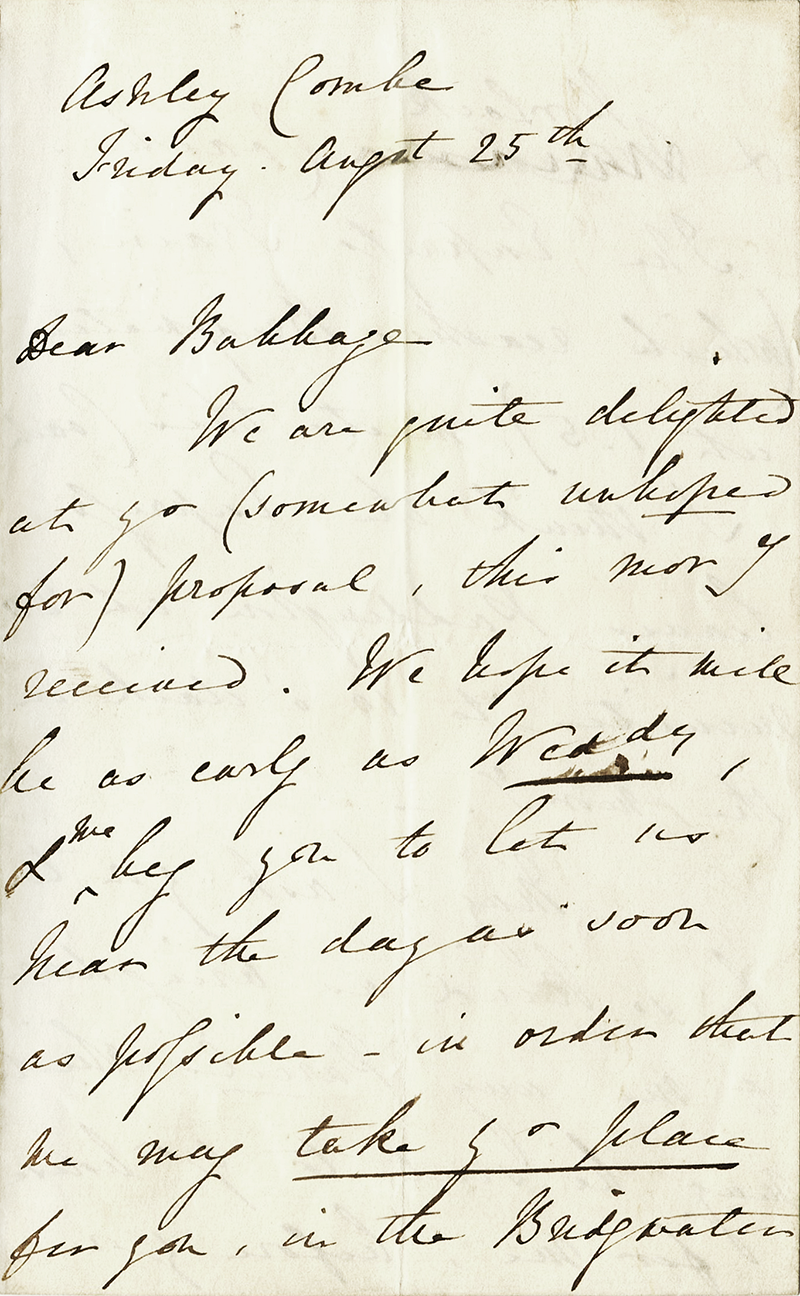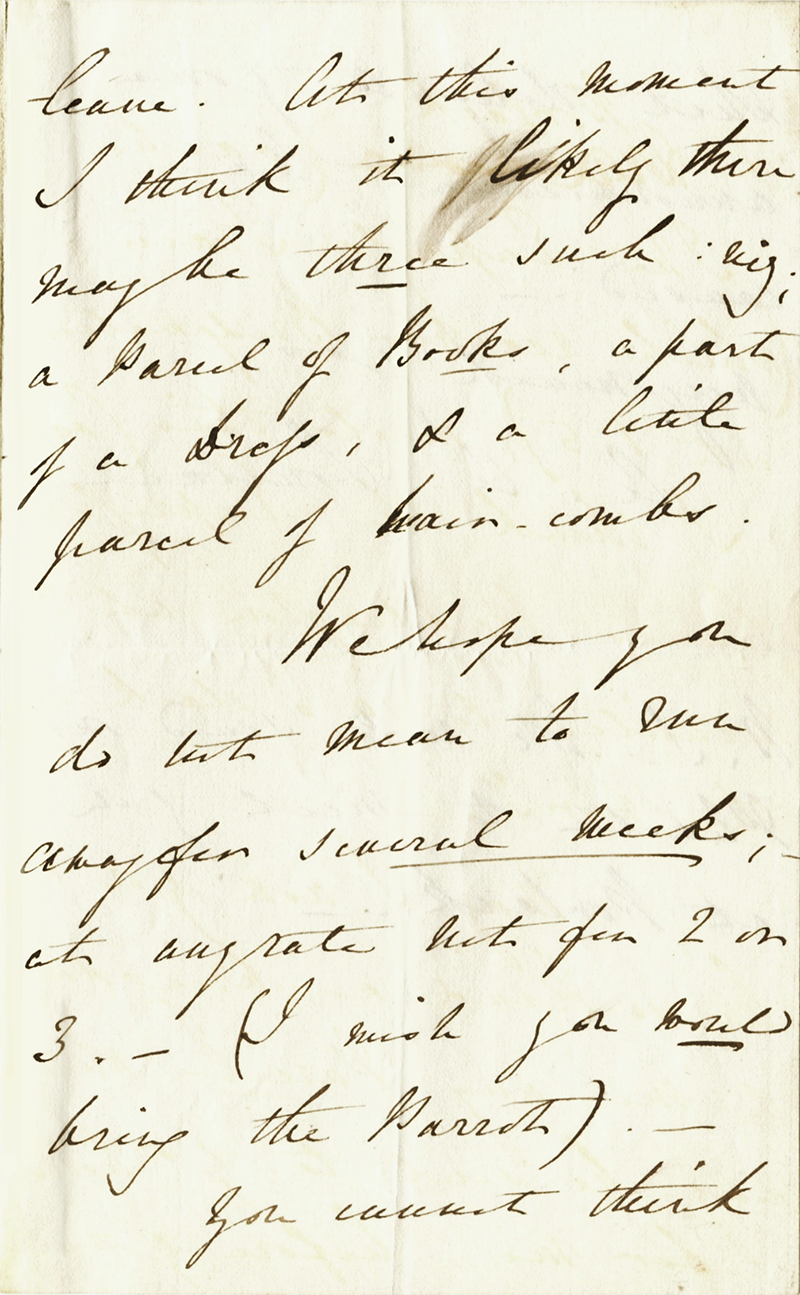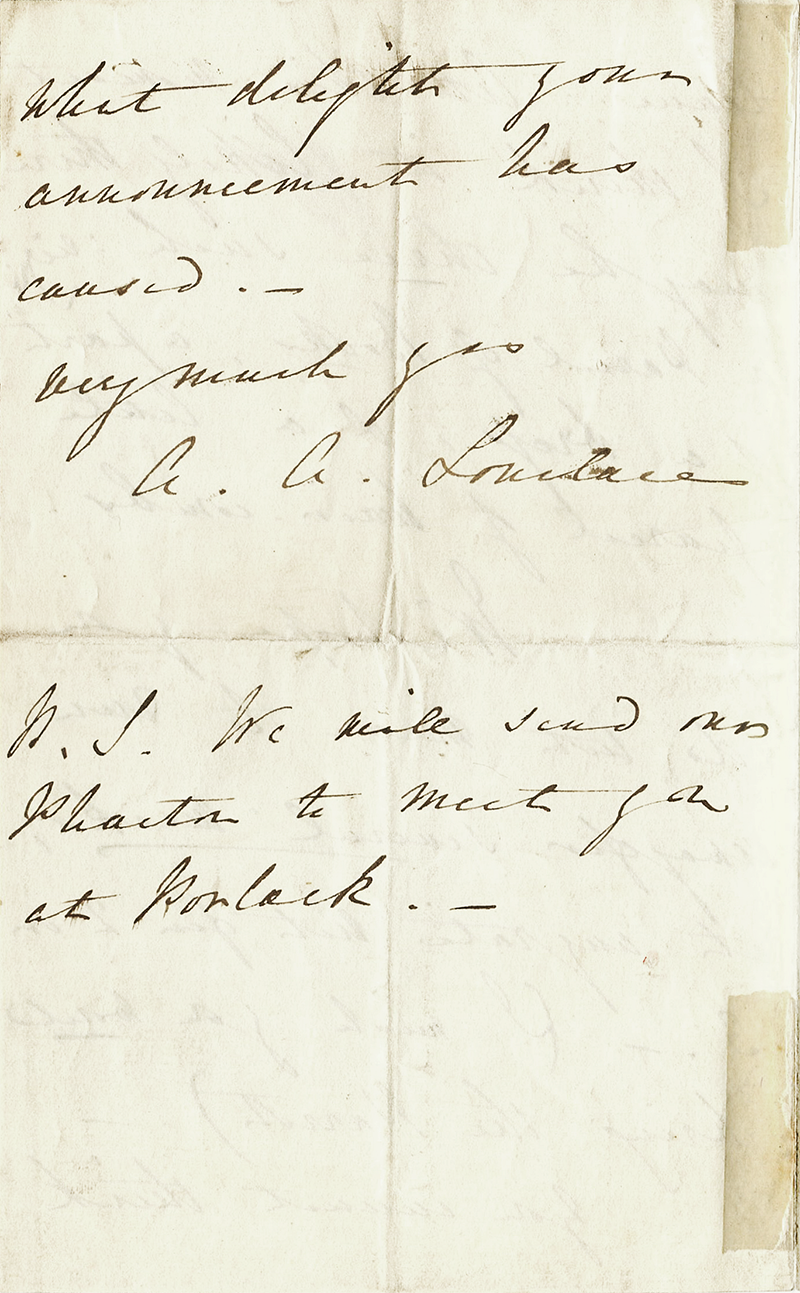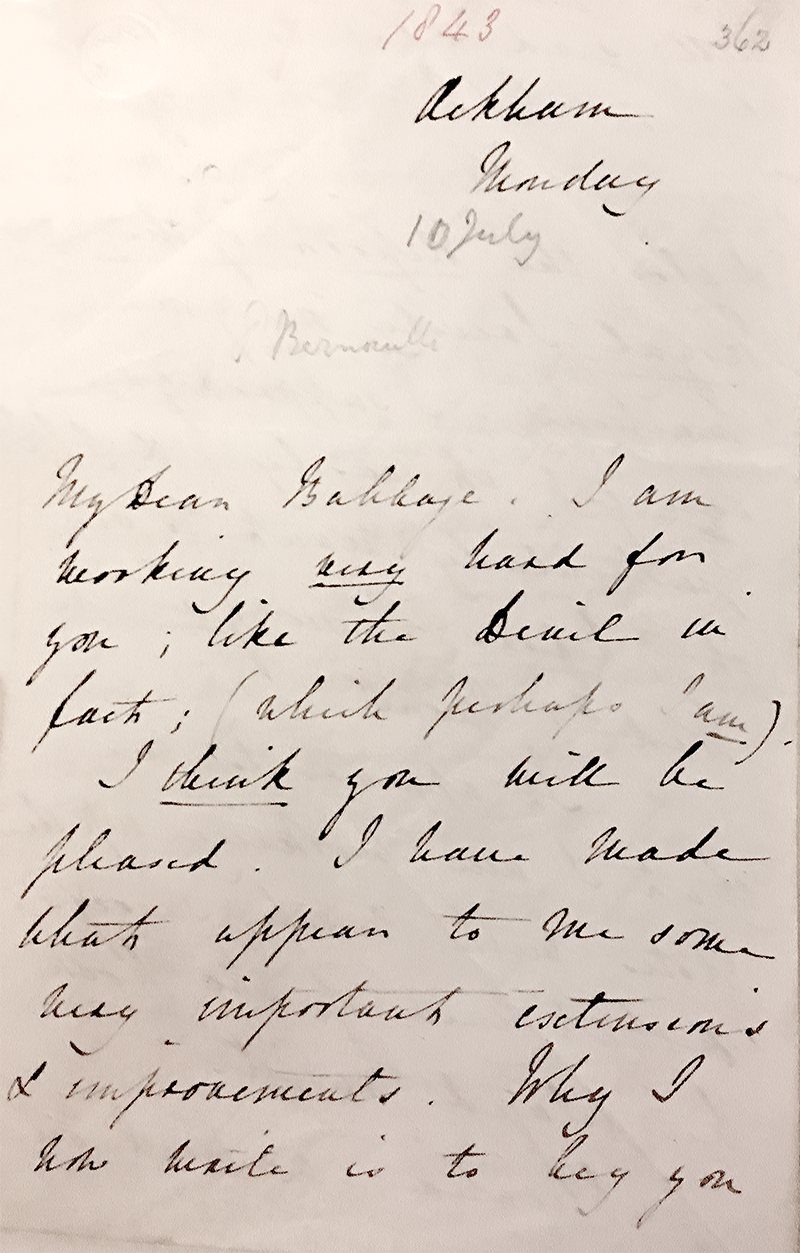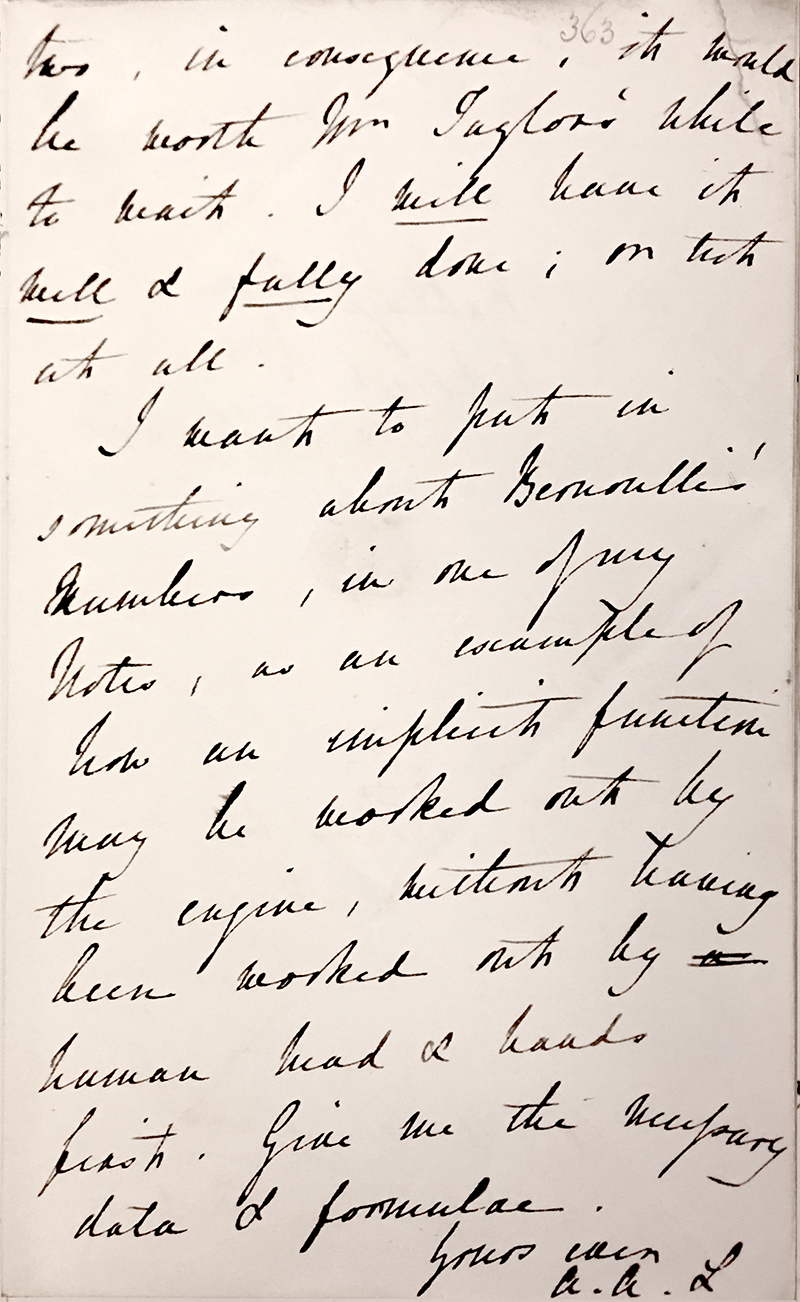Unraveling the story of Ada Lovelace (the first programmer in history)
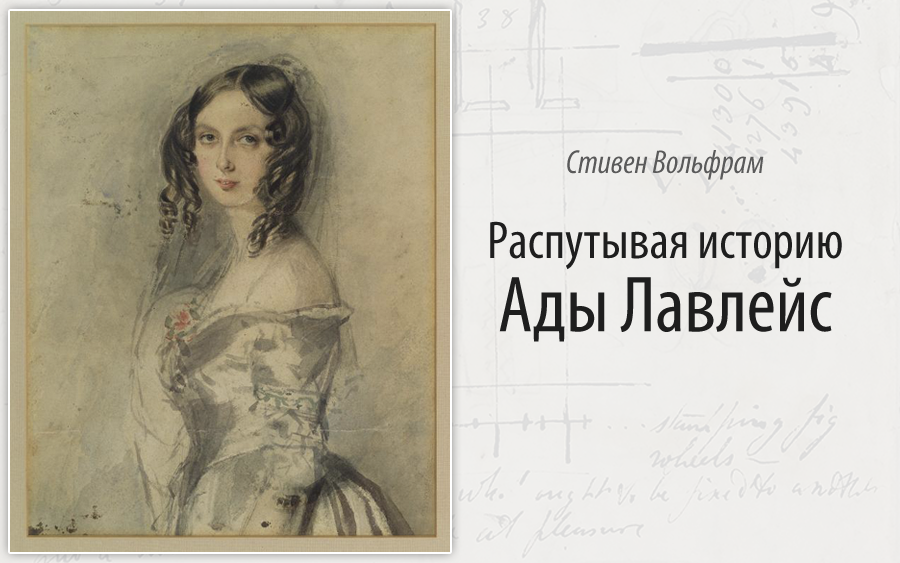
Translation of Stephen Wolfram's post " Untangling the Tale of Ada Lovelace ".
I express my deep gratitude to Kirill Guzenko KirillGuzenko for his help in translating and preparing the publication.
Content
Early years of Ada
Charles Babbage
The level of development of this area
Back to hell
Returning to Babbage
Ada article
After article
After the death of Ada
What happened to Babbage?
Reopen
What actually wrote ada
Calculating Bernoulli numbers
Babbage vs. Hell
Babbage's Secret Ingredient
On a larger scale
What if...
What were they like?
Conclusion
Ada Lovelace was born 200 years ago. For some, she is a significant figure in the history of computing; for others, a fairly overvalued personality. For a long time, I was trying to figure out how it really was. And so, to its bicentennial, I decided to understand what I called for myself the " secret of Ada ."
It turned out much harder than I expected. Historians disagree. Personality in history is difficult to learn. Technology is difficult to understand. The whole story is intertwined with the customs of the 19th century British high society. And there is an amazing amount of erroneous information and incorrect interpretations.
But after some research, including viewing a large number of original documents, I feel that I finally understood who Ada Lovelace is and what her story is. This story is full of fascinating, exciting moments, and tragic, disappointing.
')
This is a complicated story, and in order to understand it, you will need to tell a lot about it.
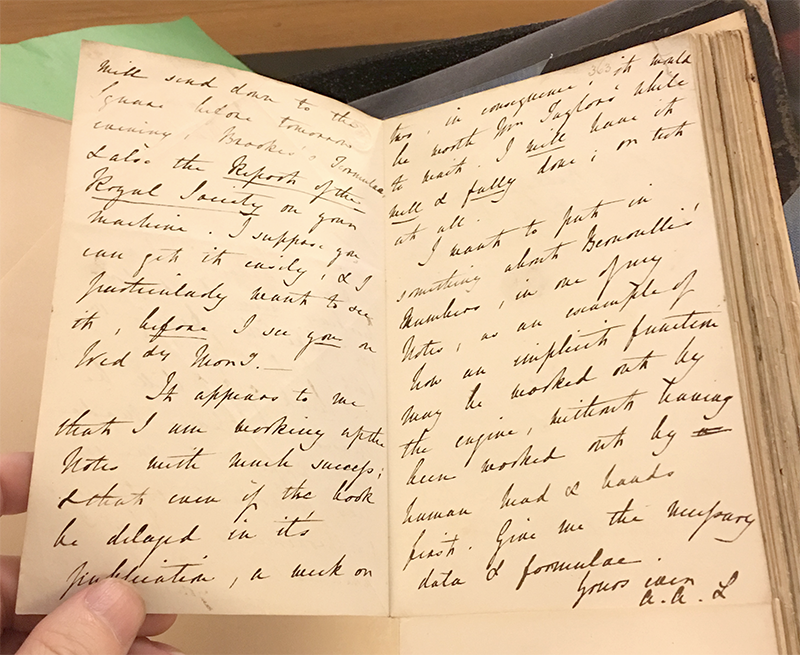
Early years of Ada
Let's start from the beginning. Ada Byron (her maiden name) was born in London on December 10, 1815, to a newly married high society couple. Her father - Lord Byron (George Gordon Byron) - was 27 years old, and at this age he gained great popularity in England thanks to his poems. Her mother, Annabella Milbank, a 23-year-old proponent of progressive thinking, inherited the title of Baroness Wentworth. Her father said that he called her Ada, because this name is short, ancient and melodious.
The parents of Ada are a study of opposites. Byron led a tumultuous life, and, perhaps, became the brightest "top bad boy" of the 19th century - with dark episodes from childhood and adolescence and lots of romantic and other stories. In addition to versification and disregarding the social norms of his time, he often did something unusual: he kept a tame bear in his room while studying at Cambridge, for example, or lived with poets in Italy and “five peacocks on the main staircase” (quote from one of his friends Byron), wrote a textbook on Armenian grammar, and if he had not died so early, he would have led the troops in the Greek War of Independence (as the big statue in Athens reminds of, despite the complete absence of military training).
Annabella Milbank was an educated, religious and very correct woman who was passionate about reforms and good deeds, which Byron called the "Princess of Parallelograms". Her marriage with Byron lasted only a short time, and fell apart when Ada was only 5 weeks old; Ada never saw her father again (even though he kept her picture on his desk and mentioned it in his poetry). He died at the age of 36 at the peak of his fame when Ada was 8 . There was a tremendous noise around him, spawning hundreds of books and a “holy war” between the sympathizers of Lady Byron (as Ada’s mother imagined herself) and Byron himself, which lasted a whole century, if not more.
Ada spent her childhood isolated on the rented estates of her mother, with governess, caregivers and her cat, Mrs. Puff. Her mother was often absent for various (rather foolish) reasons related to recreational activities, which provided Ada with a rich educational system with many hours of exercise and self-control exercises. Ada studied history, literature, languages, geography, music, chemistry, sewing, cursive and mathematics (taught partly with an empirical approach) to the level of elementary geometry and algebra. When Ada was 11, she went with her mother and entourage on a yearly trip through Europe. When she returned, she was very passionate about what she called flyiology , wondering how to reproduce the bird’s flight using steam engines.
Then Ada fell ill with measles (and, possibly, encephalitis), having spent as a result 3 years bedridden and in poor health. She managed to fully recover by the time when, according to the customs of the society of that time, the girls should join the society: closer to 17 she left for London. On June 5, 1833, 26 days after she was "represented at the Court" (that is, she met the king), she was at a reception at the 41-year-old Charles Babbage (whose eldest son was the same age as Ada). Obviously, she charmed the owner, and he invited her along with her mother to the demonstration of his newly created differential machine: a 60-centimeter tall thing on manual control with two thousand brass components, which can now be seen in the Science Museum in London:
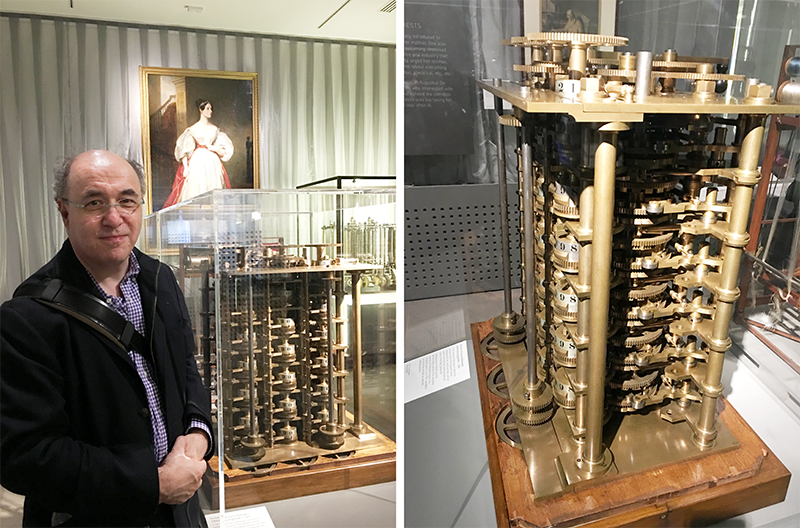
Ada's mother called her a “thinking machine,” and then said that she could find the roots of quadratic equations, as well as raise some numbers to the second and third degree. This event has changed the life of Ada.
Charles Babbage
What is the story of Charles Babbage? His father was a successful and enterprising jeweler and banker. After various schools and private teachers, Babbage went to Cambridge, where he studied mathematics, but soon got excited with the idea of modernizing the approaches to mathematics there, and with his friends (whose friendship lasted all his life) John Herschel (son of the discoverer of Uranus) and George Peacock ( later a pioneer in abstract algebra), founded the Analytical Community (which later became known as the Cambridge Philosophical Community) to promote such reforms as, say, the replacement of the point but Newton ation (British) in calculations to Leybnitsovskuyu (Continental), based on the functions.
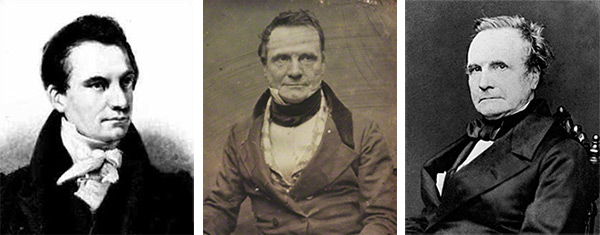
Babbage graduated from Cambridge in 1814 (a year before Ada Lovelace was born) and went with his wife to live in London, where he realized on the scientific and social scene. He did not have work as such, but he lectured on astronomy and wrote several well-accepted articles in various mathematical fields (functional equations, infinite works, number theory, etc.), and was supported by his wife’s family and father.
In 1819, Babbage visited France and learned about a large-scale government project to create tables of logarithms and trigonometric functions. Mathematical tables in those days were of great importance in the military and commercial fields, were used in science, finance, engineering calculations, navigation. It was often said that errors in the tables could stranded the ships and destroy bridges.
Returning to England, Babbage together with Herschel founded a project to create tables for their new astronomical community, and in trying to test these tables, they say, Babbage exclaimed: “ Pray for God, let these tables be received by the power of steam! ”, Which marked the beginning his life-long labor in an attempt to mechanize the creation of these tables.
The level of development of this area
Mechanical calculators were long before Babbage . Pascal made it in 1642, and now we know that in ancient times there was at least one. But at the time of Babbage, such machines were very rare and not reliable enough for regular use. The tables were created by people - calculators (this was a profession), the work was distributed by team, and the lowest-level calculations were based on the evaluation of polynomials (say, decomposition in a row) using the difference method.
Babbage thought that there could be such a device — a difference machine — that would be able to calculate any polynomial to a certain degree by means of a difference method, which would then automatically produce a result, reducing the human factor, thereby to zero.
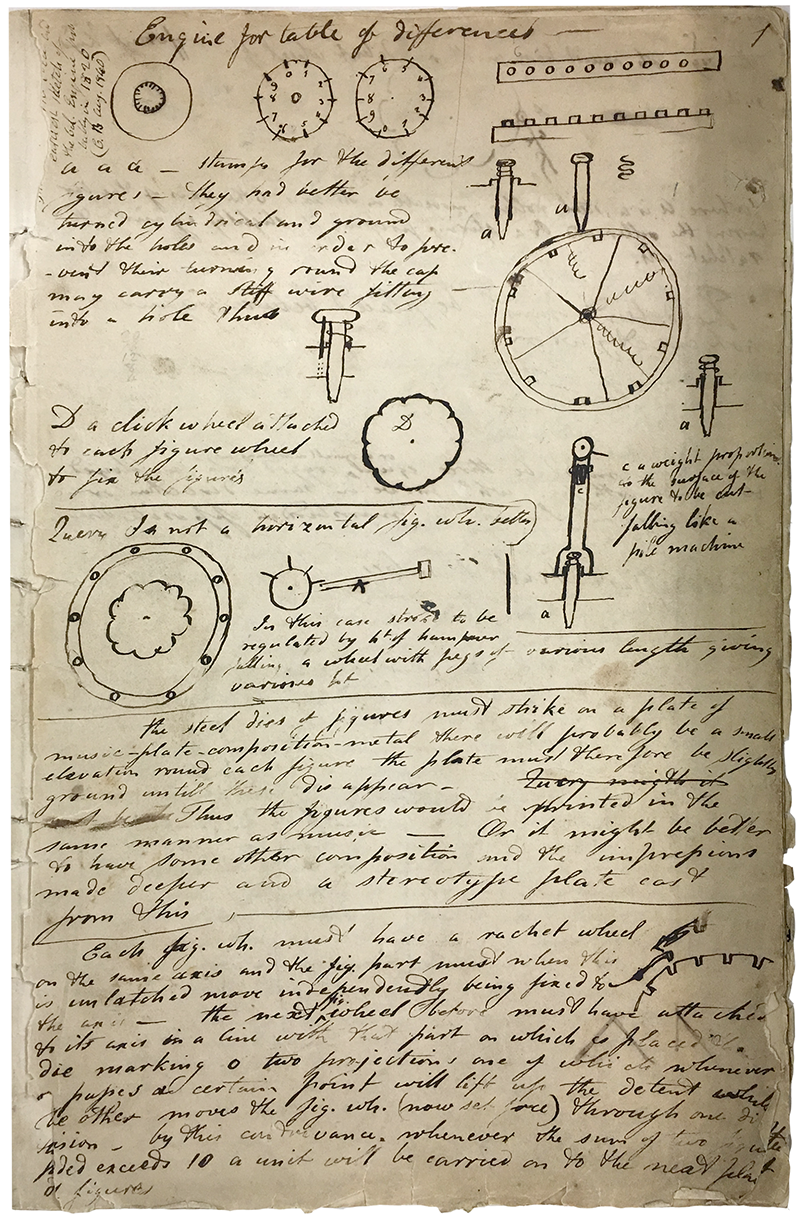
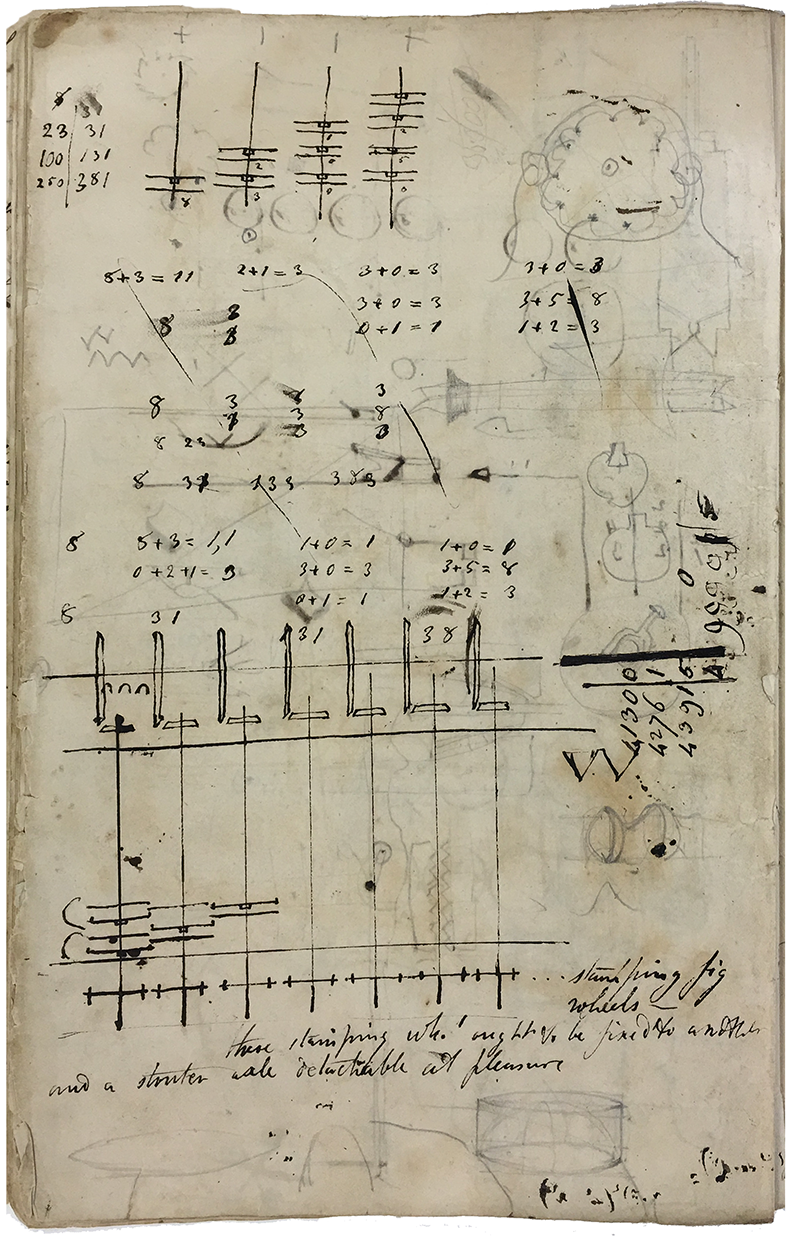
(Museum of the History of Science)
By the beginning of 1822, the 30-year-old Babbage studied various types of mechanisms, creating prototypes and thinking about what a difference machine could be. The astronomical community in which he was co-founder, awarded him a medal for the idea, and in 1823 the British government agreed to provide funding for the creation of such a machine.
In the 1824th, Babbage slightly deviated from the topic with his idea of a life insurance company, for which he had made many calculation tables. However, he equipped the workshop in his stable (in his “garage”) and continued to work out ideas on how to implement a differential machine using the components and tools of his time.
In 1827, the manual logarithm table was finally completed, after which it was reprinted for about one hundred years. Babbage printed these tables on yellow paper, pursuing the idea that it would reduce the number of errors when using them. (When I was in elementary school, tables with logarithms were still the fastest way to calculate works).
In addition, in 1827, Babbage's father died, leaving him a legacy of about one hundred thousand pounds sterling, which is approximately $ 14,000,000 in modern terms, and this money ensured the life of Babbage until the end of his life. In the same year, however, his wife died. She left him with eight children, of which only three survived to adulthood.
Depressed by the death of his wife, Babbage set off on a journey through continental Europe, and, impressed by the scientific achievements he saw, wrote a book, Reflections on the Decline of Science in England , which gave rise to sharp criticism from the Royal Society (of which he was a member).
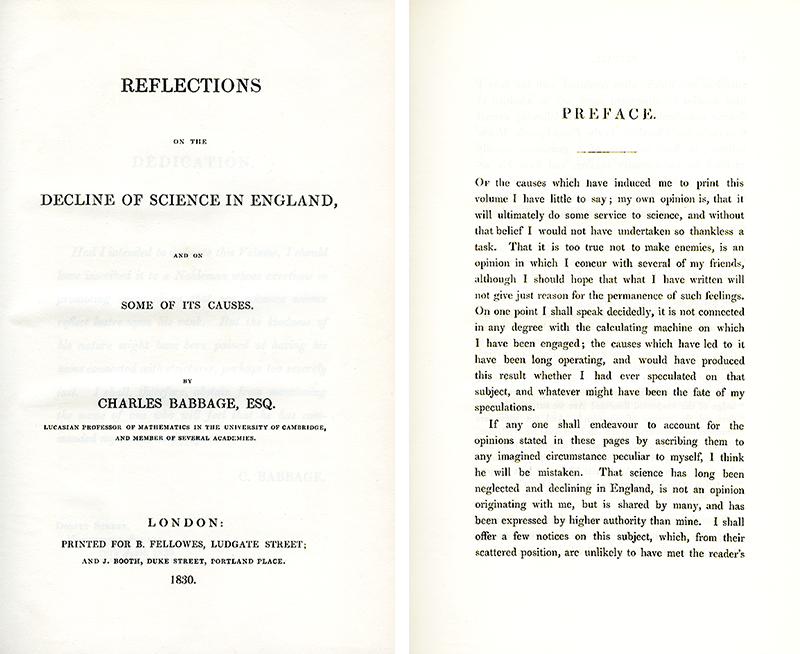
Allowing and often distracting, Babbage continued to work on the differential machine, producing thousands of pages with notes and drawings of structures. He was very good at creating drawings and experimenting with mechanisms. But in managing the engineers he hired, he was not very strong, nor was he in financial management. However, by 1832, a small working prototype of a differential machine (without a printing device) was successfully completed. And that was exactly what Ada Lovelace saw in June 1833.
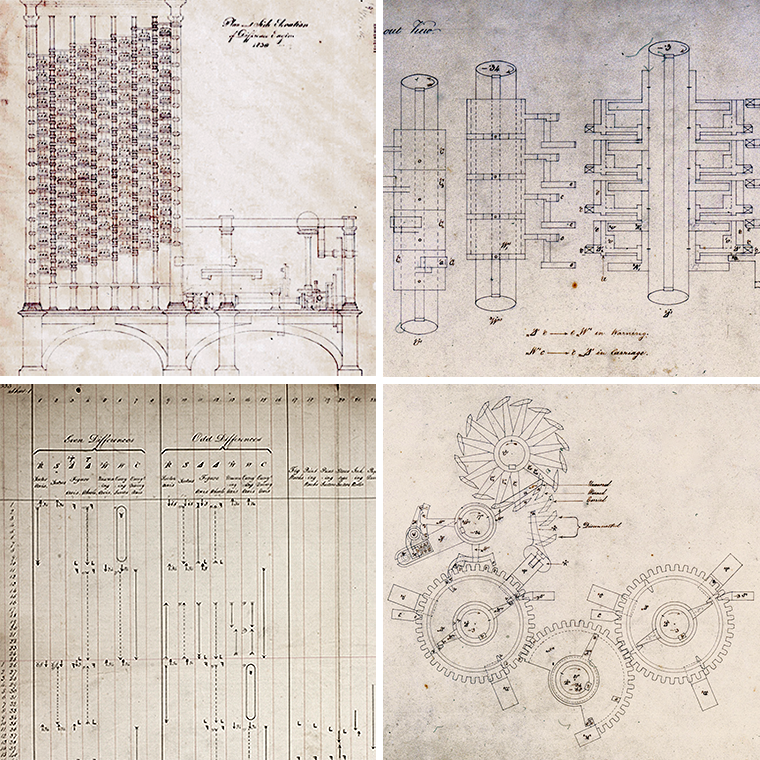
(Science Museum / Image Library Science and Society)
Back to hell
Perhaps it was after Ada saw the difference machine that interest in mathematics awoke in her. She met Mary Somerville , a Laplace translator and a renowned interpreter of science, and, partly under her influence, soon began to study the works of Euclid with enthusiasm. 1834th Ada took part in a charity trip to the factories of northern England, arranged by her mother, as a result of which she was impressed by their high-tech samples by the standards of those times.
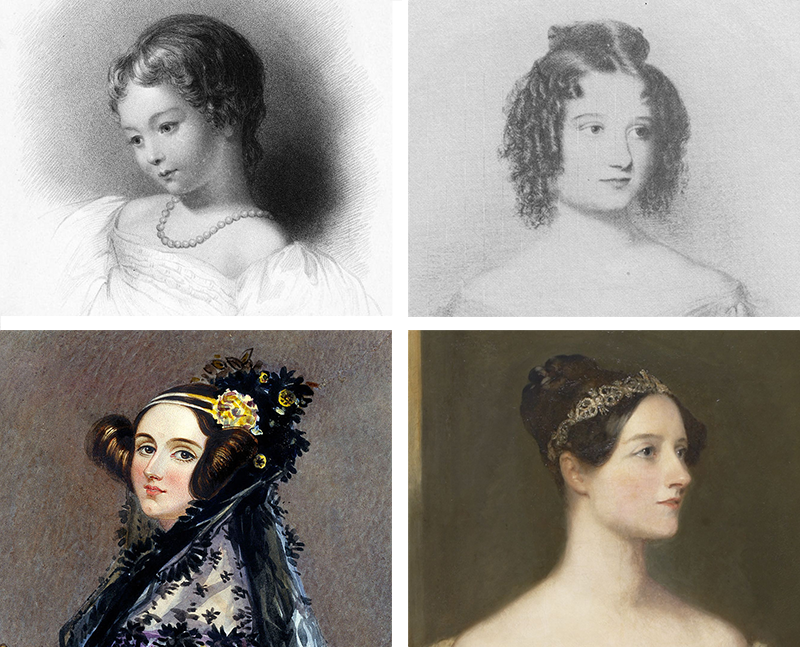
On his return, Ada taught some of the daughters of her mother’s friends to mathematics. She continued to conduct classes by mail, noting that this could be "the beginning of mathematical correspondence for many years between two ladies of higher rank, which, no doubt, can later be published as an instruction to humanity (mankind) or its female part (womankind words; man and as a man, and as a man) ". Ada’s letters did not contain complex mathematics, but she expressed herself very clearly, accompanying letters with instructions like “you should never limit yourself to indirect evidence, if you can give a direct one .” (Much that Ada wrote in her correspondence underlined here is in italics).
Babbage, perhaps, at first underestimated Ada, trying to interest her in the toy, which is a mechanical doll ( Silver Lady automaton toy ), which he demonstrated at his receptions. But Ada continued to communicate with Babbage and Somerville - both separately and together. And soon Babbage dedicated it to a variety of topics, including the problem of state funding for his project to create a differential machine.
In the spring of 1835, when Ada was 19, she met William King, 30, (or, to be exact, Lord William King). He was a friend of the son of Mary Somerville, he studied at Eton (in the same school that I went to 150 years later) and Cambridge, and then was a civil servant, later on the outpost of the British Empire in the Greek islands. William seemed to be an accurate, conscientious, and decent man; maybe a little tough. But, in any case, Ada with him quickly began to spin, and on July 8, 1835, they got married, not declaring it to the last minute, fearing publicity and undue attention of the press.
The next few years of Ada’s life seem to be devoted to raising three children and managing a large farm, although she spent some time riding, learning how to play the harp and mathematics (including topics such as spherical trigonometry). In 1837, Queen Victoria (who was then 18) ascended the throne, and, as a member of high society, Ada met with her. In 1838, in connection with his public service, William was awarded the title of count, and Ada became the Countess of Lovelace.
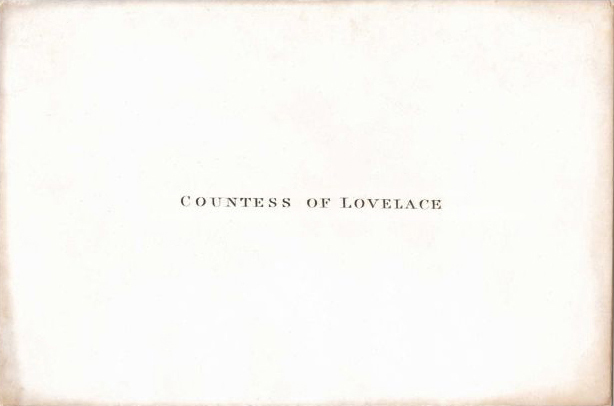
(Powerhouse Museum in Sydney)
A few months after the birth of the third child in 1839, Ada returned to mathematics with a serious attitude. She told Babbage that she wanted to find a math tutor in London, asking not to mention her name, probably fearing publicity.
Ada was introduced by Augustus de Morgan, the first professor of mathematics at University College London, an eminent logician, author of several textbooks, and not only Babbage’s friend, but also the husband of the daughter of Ada’s primary childhood teacher. (Yes, it was a small world. De Morgan was also a friend of George Boole and a man who, though indirectly, was the cause of the emergence of Boolean algebra ).
In correspondence with Babbage, Ada showed interest in discrete mathematics and was surprised, for example, that solitaire " can be reduced to mathematical formulas and solved ." But in accordance with the traditions of the mathematical education of that time (which also apply to our time), de Morgan taught Ada a mathematical analysis.

(British Library)
Her letters to de Morgan regarding calculus were not particularly different from those for students studying mathematical analysis in our day, but were something very unusual for the times of Victorian England. Even many of the misconceptions are the same, although Adu was more than usual touched by bad designations in the calculations (" why not multiply by dx? ", Etc.). Ada was a stubborn student, and seemed to delve into the depths of mathematics with pleasure. She was glad of the discovery in herself of mathematical abilities and their high appreciation by de Morgan. She kept in touch with Babbage, and in one of his visits (in January 1841, when she was 25 years old), she charmingly told the 49-year-old Babbage “If you skate , promise to bring skates to Ockham; this is the most fashionable place now, which is a must visit. ”
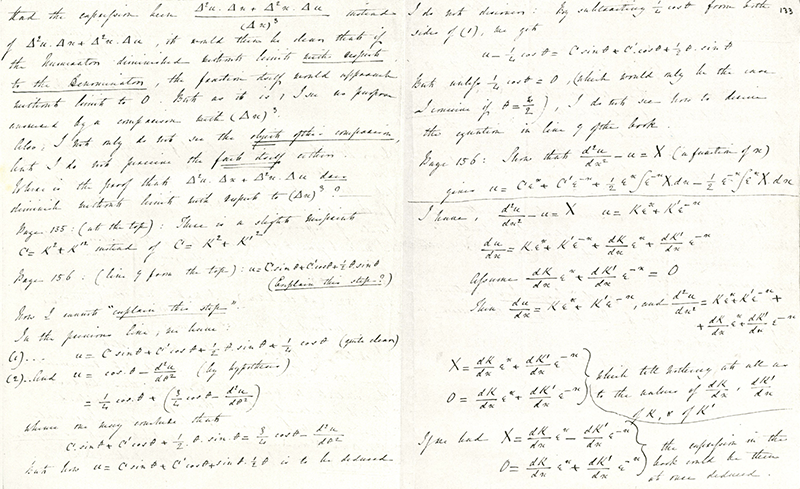
Ada’s relationship with her mother was very complex. From the outside, Ada seemed to treat his mother with great respect. But it seems that she constantly encountered her mother’s attempts to control her and manipulate her. Ada's mother often complained about her health, she lamented that she was about to die (but in fact she lived to be 64 years old). She often criticized Hell for parenting, housekeeping, and social behavior. But on February 6, 1841, Ada had enough confidence in herself and her studies in mathematics to write a very detailed letter to her mother about her thoughts and aspirations.
She wrote: " I consider myself the owner of a very rare combination of qualities, ideally suited to make me the discoverer of the hidden realities of nature ." She spoke about her ambitions in creating great things, about her “irrepressible and restless energy”, which, in her opinion, she found an application. And she said that after 25 years she became less “secretive and suspicious” towards her.
But three weeks later, her mother told us that Byron and his stepsister had a baby before Ada was born, and this news knocked her out of a rut. Incest in those days in England was not something illegal, but it was a scandal. Ada had a hard time accepting this, and for a while she moved away from mathematics.
Ada occasionally had health problems, and in 1841, apparently, the situation worsened, and she began to systematically take opiates. She really wanted to succeed in something, and began to think that maybe she should devote herself to music and literature. But her husband William seemed to dissuade her from this idea, and at the end of 1842 she returned to mathematics.
Returning to Babbage
What did Babbage do all this time? A variety of things and with varying success.
After several attempts, he was able to establish himself as a Lukasov's professor of mathematics at Cambridge, but later he didn’t go there. Nevertheless, he wrote, as it later turned out to be a very important book - The Economics of Technology and Production (On the Economy of Machinery and Manufactures), which described how to distribute production tasks (a question that actually arose in connection with calculations of mathematical tables).
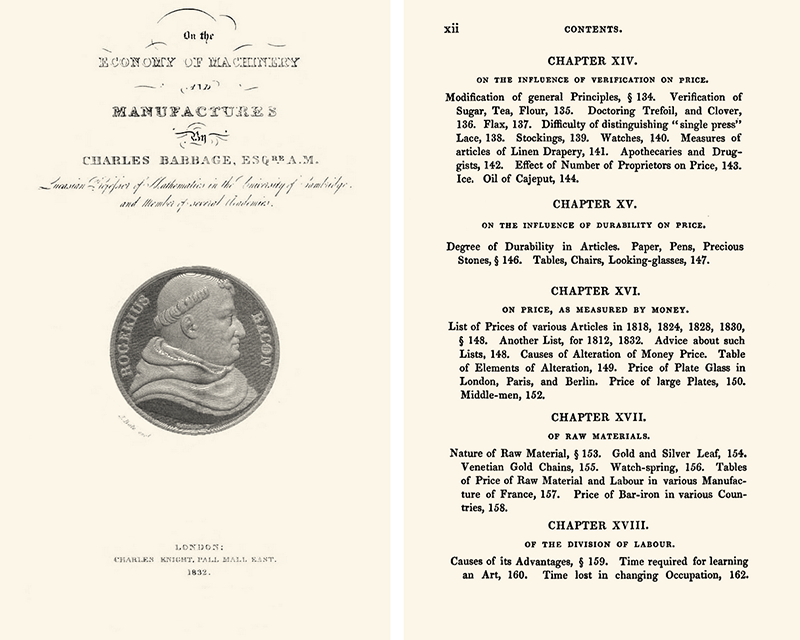
In 1837, he practiced natural theology in those days, adding his Ninth Treatise of Bridgewater to a series of treatises written by other people. The central question sounded something like this: “ Are any observable features of nature and the environment proof of the existence of God? ” Babbage’s book is quite difficult to read (and translate!); Take, for example, a quotation: “The concepts that we draw from our plans and plans are born from a comparison of our observations of the creation of other beings with aspirations in which we see our own beginnings. "(“ The notions we’re not aware of contrivance and design come out of our own undertakings. ”)
Clearly resonating with some thoughts from my work , published 150 years later, he talks about the relationship between mechanical processes, the laws of nature and free will. In his book, he argues that " complex calculations can be carried out using mechanical means, " but then he continues to assert (citing very weak examples) that a mechanical engine can produce sequences of numbers that demonstrate unexpected changes, comparing this with a miracle.
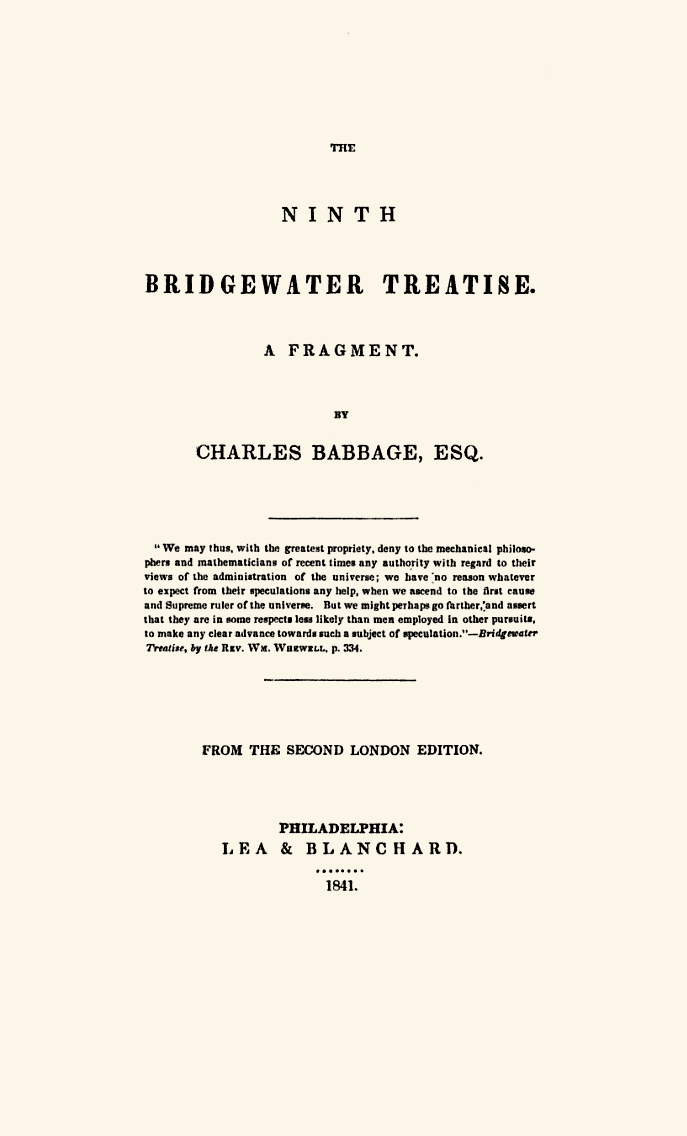
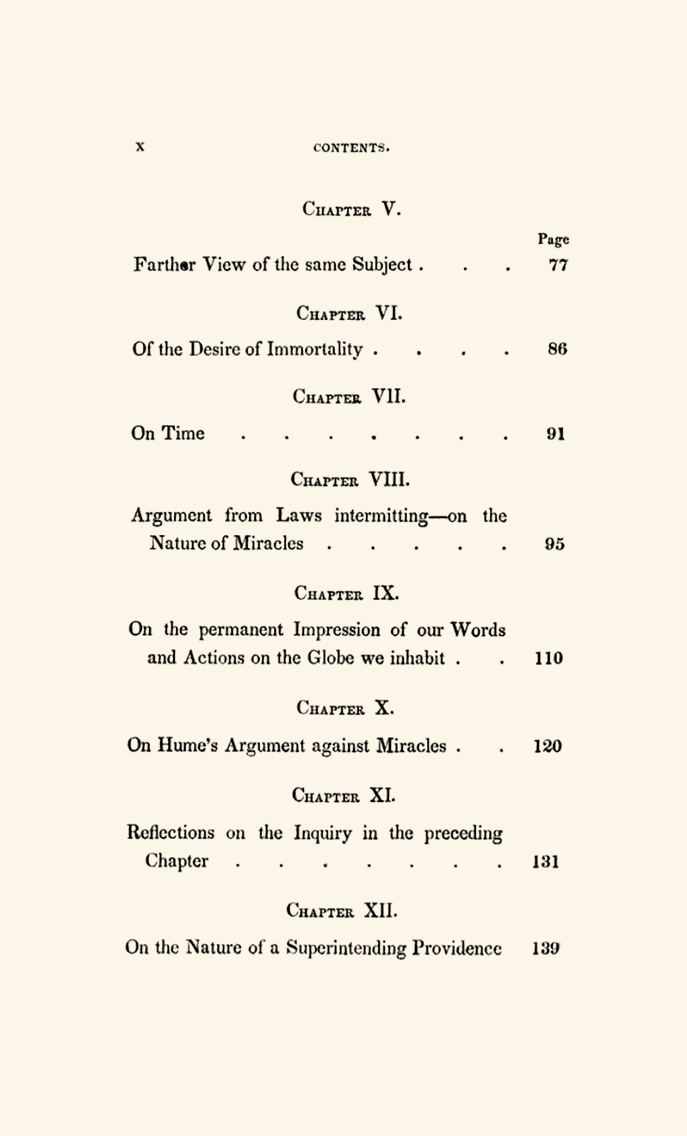
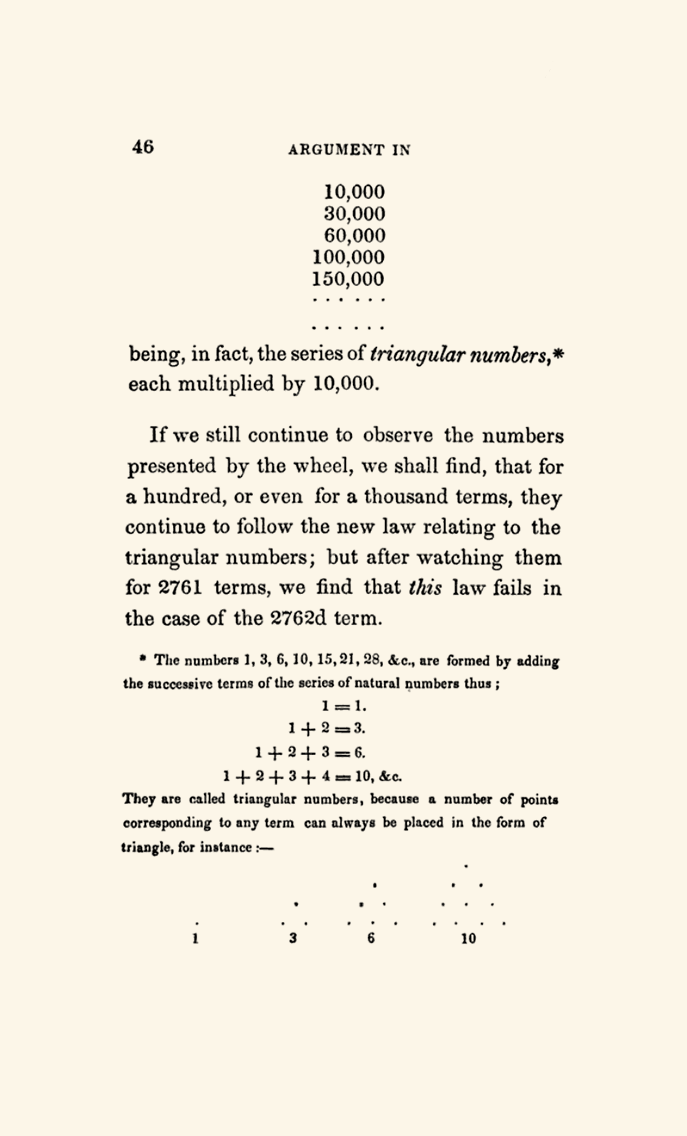
Babbage tried his hand at politics, twice ran for parliament with an industry-oriented program, but was unable to win the election, in part because of claims of abuse of government money allocated to the differential machine.
, , , , , , . , , , , .

. . , - , , . 1833 ; , , , , .
, . , , " ", , . , - , , , , , , , . , , , , , 1801 .
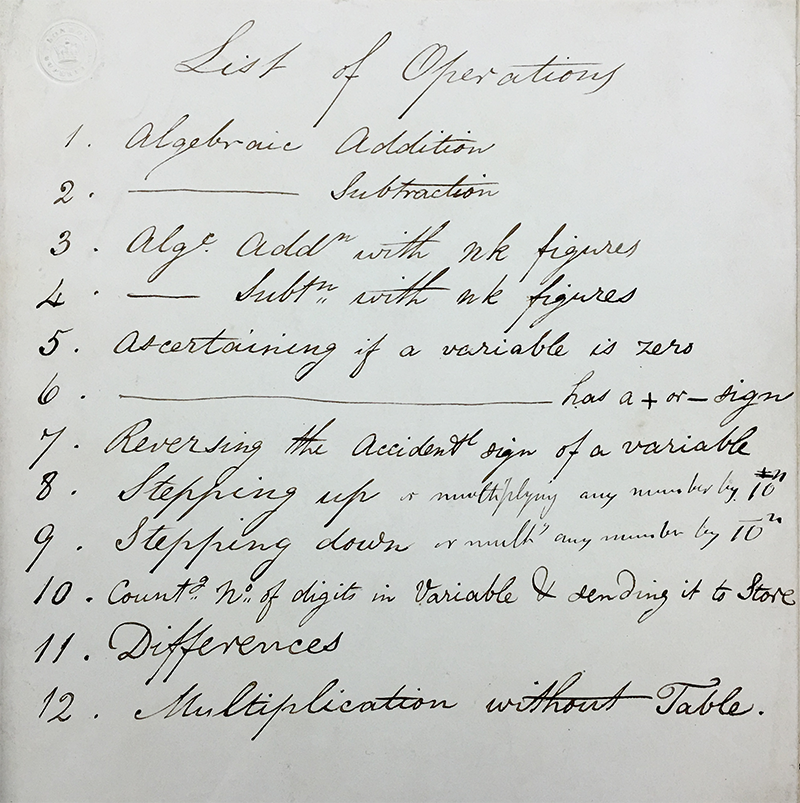
( )
, , . 1826- , , " ". , .
1826- , . , , , . , , , .
£17 500, $2 000 000. , , , . , , , ( .). , £20 000 — ( , ) . , №2, 8000 25 000.
1842 , - ( ), , . , , . ( , , , Wolfram|Alpha .)
, , 1840 , .
, . — 30- , 27 - ( ).
1842 , . , . , , , . , 1843 .
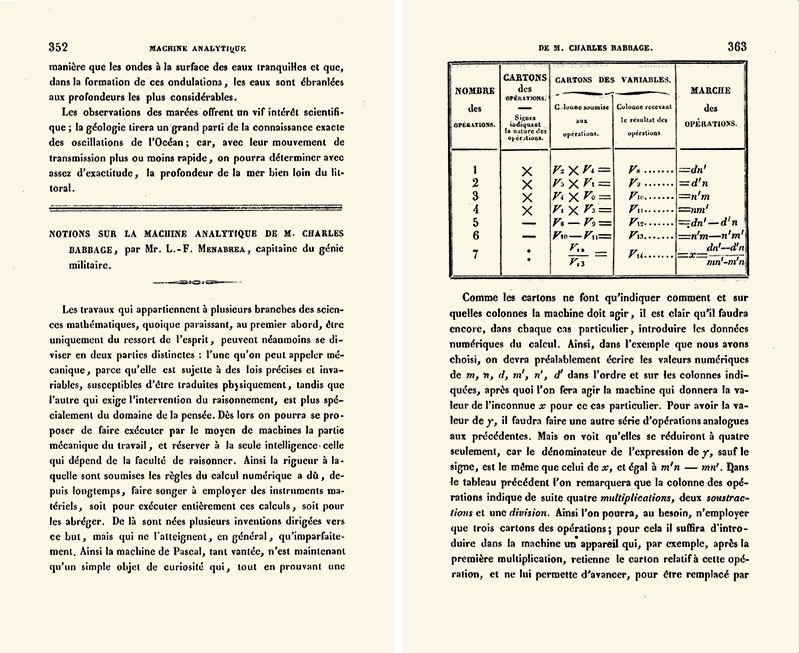
, ( « »). ( 6 ), ( , ), e-mail, , , . ; ; - ; . , , , , , , .
, : " . , , … . Tant mieux ( – .). " : " , . . , . " , ( « .», ) " . ... "
...
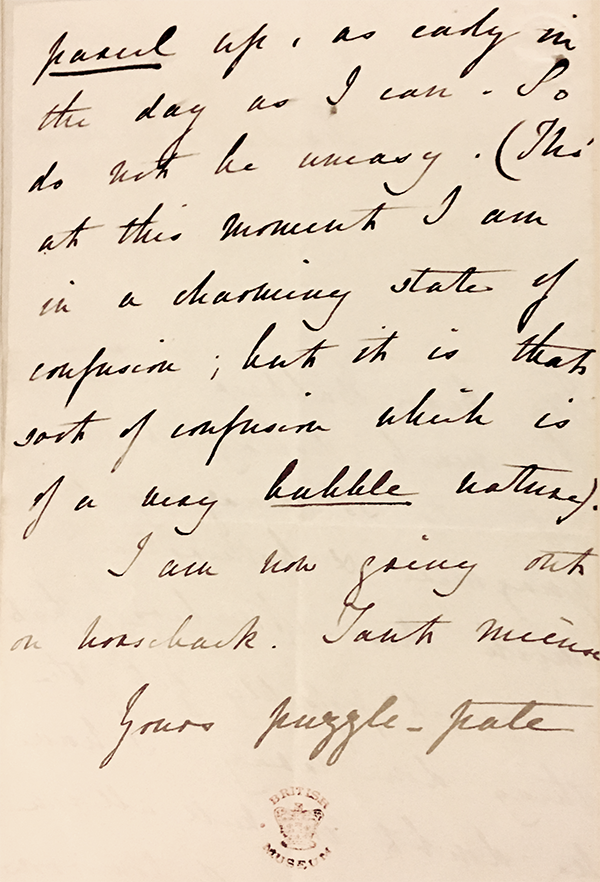


, . : " – , , , , AAL " ( ).
1843 . , . : ( ), , . . , , . , . , , «AAL» , « ».
, , " , . , , , - ". , , , " , . , . "
. , " , , ". , .
. , .
, 14 1843- 16- . ( , .) , , «» , « ». , « , … , , ...» : « - … - … ; ...»
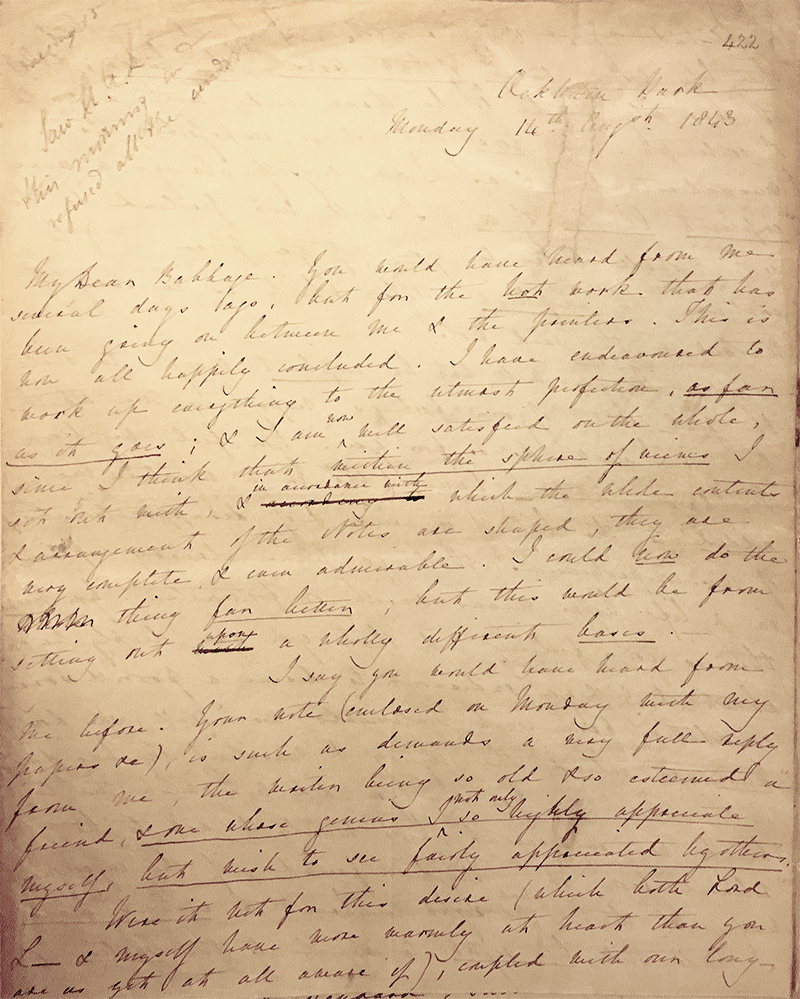
, , . , . , . : « ...», « … .» : « , . , ... , , , , .»
: «, (lady-fairy)?»
« .» : « . , . ...»

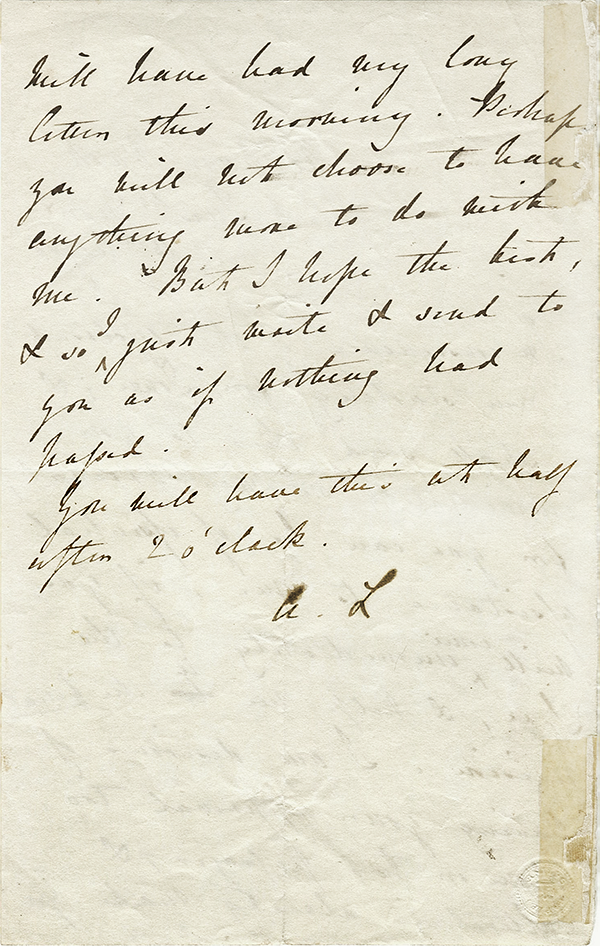
(- )
5 : « , … … , … , ; . , , , (, , , , , , ). . , ».
: « AAL .»

, 18 , , . : « ( ) » ( ). : « , , , -. , ! „
...
, 9 , () “ » « ». (, , «», «»).

: « , !», « ». " ".
But unfortunately, everything did not turn out as expected. For a while, Ada was engaged in family and household chores, abandoned during the period when she was focused on her notes. But after her health was greatly shaken, and she spent many months on doctors and various “healers” (her mother offered her “mesmerism,” that is, hypnosis).
However, she still admired science. Ada talked with Michael Faraday , who called her "the rising star of science." She spoke of her first publication as “ her firstborn ,” “in colors and with subtexts (very implicitly expressed) about her very general and extensive metaphysical ideas.” She wrote: “He (her work; she calls him“ He ”- approx.) Will become (as I hope) an excellent head of a large family with a large number of brothers and sisters.”
When her notes were published, Babbage said: “You should write your own article. However, if you wait a little, you can make it even more beautiful. ” But in October 1844, David Brewster (the inventor of the kaleidoscope, among other things) decided to write about the analytical machine, and Ada asked what Brewster might have to offer another topic for her, saying: " I think that some topics from the field of physiology could suit me; however, like any others . "
Indeed, in the same year, she wrote to her friend (who was also her lawyer and son of Maria Somerville): “I do not think that brain structures are less subject to mathematicians than the movements and properties of stars and planets ; well, if you choose to consider the correct point of view. I would like to leave to subsequent generations a computed model of the nervous system . ”An impressive vision, and this is 10 years before, for example, George Boole raised the question about such things .
Both Babbage and Mary Somerville began their research careers with translations, and she saw the same path for herself, saying that her next work might be reviews of Wavelle and Ohm , and that she may eventually become a " prophet from science . "
Of course, she had obstacles. As, for example, the fact that women in those days did not have access to the Royal Society Library in London, although her husband, in part because of her efforts, was a member of this society. But the most serious problem was still the health of Ada. She had many problems, although in 1846 she still spoke with optimism: “We need only another year or two of patience and our own health. "
There were also problems with money. William had an endless series of complex and often quite innovative construction projects (it seems he was especially interested in towers and tunnels). And with a request for funding, they were forced to turn to Ada's mother, who was often difficult to deal with. The children of Ada had already entered adolescence, and she had to spend a lot of time with them.
Meanwhile, she had a good relationship with Babbage, she began to see him more often, although in her letters she talks about dogs and domestic parrots more often than about the analytical machine. In 1848, Babbage had a rash idea to create a tic-tac-toe machine to conduct a tour of the country in order to raise money for its projects. Hell dissuaded him. The center of Babbage's idea was a meeting with Prince Albert to discuss his cars, but this never happened.
William also published. He already had brief works with such names as “the method of growing beans and cabbage on the same land” and “About beet Mangold” . But in 1848 he wrote another article comparing the productivity of agriculture in France and England, based on detailed statistical data, with remarks like " It is easy to show that the French are not just much worse than the British, but also that they now feed even worse than in the worst times of the empire. "
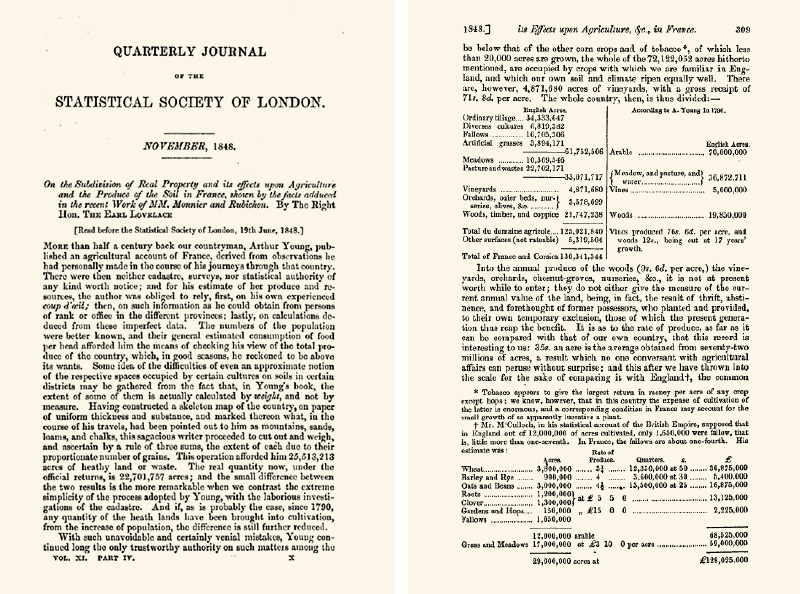
The 1850s were an important year for Ada. She and William moved to a new home in London, as a result, increasing their presence on the London academic scene. She was deeply impressed after she first visited the house of her father’s family in the north of England, which caused her to argue with her mother. Then she became interested in betting on horse racing and lost some amount on it. (It’s impossible not to say that it was in her or Babbage style - to develop some kind of mathematical scheme for bets, but there is no evidence that they were doing this.)
In May 1851, a world exhibition opened at the Crystal Palace in London. (When Ada decided to visit her in January, Babbage wrote to her: " Please put on woolen stockings, cork shoes and any other things that will keep you warm. ") The exhibition showed advanced manifestations of Victorian science and technology, and Ada, Babbage and their scientific community was impressed (although Babbage expected more). Babbage handed out leaflets on the mechanical notation in large quantities. William received an award for a decision in the field of brick production.
However, this year the health situation of Ada has become very difficult. For a while, her doctors simply advised her to spend more time at sea. But in the end they discovered she had cancer (based on what we know now, most likely it was cervical cancer). Opium no longer repressed pain; she began experimenting with marijuana. By August 1852, she wrote: “ I begin to understand death; she quietly and steadily steals up every minute, and she will never be a matter of any particular moment. ” And on August 19 she asked Babbage's friend Charles Dickens to come to her and read the story of death from one of his books.
Her mother moved into her home, keeping other people away from her, and on September 1, Ada made some unknown confession, which clearly upset William. She seemed to be close to death, but, overcoming pain, she lasted another three months, and eventually died on November 27, 1852, at the age of 36. Florence Nightingale , who looked after Ada and was her friend, wrote: " They say that she could not live so long if it were not for the enormous vitality of her brain, who did not want to die. "
Ada chose Babbage as her performer. And, to her mother’s chagrin, she was buried in Byron’s family vault next to her father, who, like her, died at the age of 36 (Ada lived 266 days longer ). Her mother built a memorial on which was kept a sonnet called “Rainbow”, written by Ada.
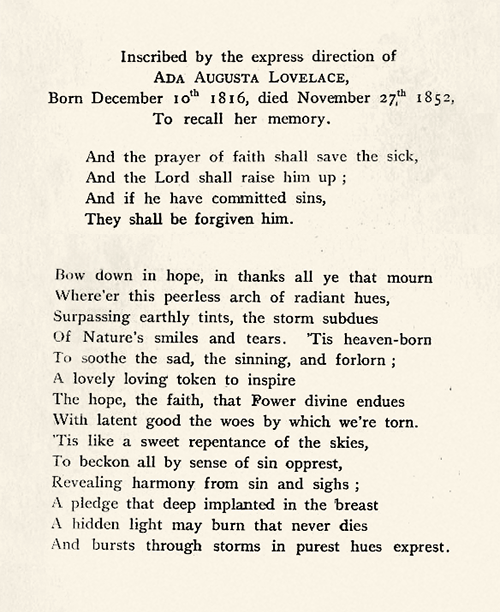
After the death of Ada
Ada’s funeral was modest; Neither her mother nor Babbage were present. But the obituaries were benevolent, in the spirit of the Victorian era:
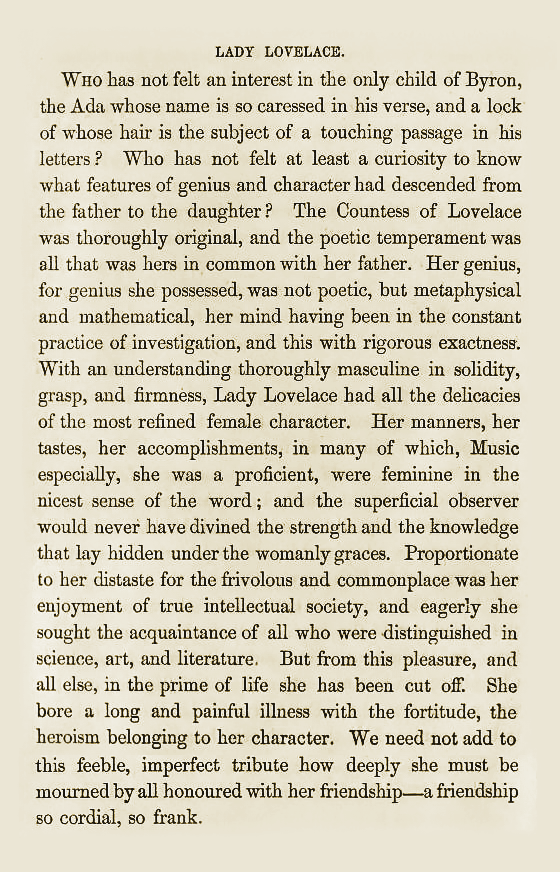
William survived her for 41 years, eventually remarrying. Her eldest son, with whom Ada had many difficulties, joined the Navy several years before her death, but after he deserted. Ada thought he might have gone to America (apparently, he was in San Francisco in 1851), but in fact he died at 26 while working at a shipyard in England. Ada’s daughter married a very eccentric poet, spent many years in the Middle East, and became the world's largest breeder of races. Ada's youngest son inherited the family title and spent most of his life on the estate.
Ada's mother died in 1860, but even then gossip about her and Byron continued to appear in articles and books, including Lady Byron, acquitted of 1870 by Harriet Beecher-Stowe . In 1905, a year before his death, the youngest son of Ada, brought up mostly by his grandmother (mother of Ada), published a book about all of this, with the main theme in the style " there is nothing interesting in the life of Lord Byron, except has been repeatedly discussed . "
When Ada died, her personality was overgrown with a whole ball of gossip and rumors. Did she have any novels? Did she have huge gambling debts? Arguments and evidence were very scarce. Perhaps this was a reflection of the ideas about her bad father. But long before that, there were rumors that she pawned (twice!) Her family jewels, and lost, as some have said, £ 20,000, or maybe even £ 40,000 (equivalent to about $ 7,000,000 in today's money) on horseback rates .
It seemed that Ada's mother and her youngest son were opposed to her. On September 1, 1852, on the day of her confession to William - Ada, she wrote: “ My earnest death address to all my friends who have letters from me: give them to my mother Lady Noelle Byron after my death. ” Babbage refused. The rest agreed. But later, when her son systematized them, he decided to destroy some of them.
True, many thousands of pages from Ada’s letters are still scattered around the world. Letters and answers to them are similar to modern correspondence - arrangements for meetings, talks about health and ailments. Charles Babbage complains about the postal service. Three sisters from Greece ask Ada for money, because their deceased brother was a page by Lord Byron. Charles Dickens talks about chamomile tea. A courtesy from a man with whom Ada met at Paddington Station. And calculations for the housekeeping, diluted with notes, inserts of musical parties, recipes of various sweets. And then, mixed with all of the above, serious intellectual discussions about the analytical machine and many other things.
What happened to Babbage?
So what was with Babbage? He lived another 18 years after the death of Ada and died in 1871. He tried to continue working on the analytical machine in 1856, but did not achieve much success. He wrote articles like " Statistics on lighthouses ", " Table of relative frequencies for the causes of destruction of glass windows ", " On ancient artifacts of human art mixed with the bones of extinct species of animals ."
Then, in 1864, he published his autobiography - Excerpts from the life of the philosopher - a very strange and bitter creation. The chapter on the analytical machine opens with a quote from Byron's poem - “ Kohl are wrong, then revenge for it ” (“Man wrongs, and Time avenges”; O. Chyumina in the 1905th translated: “ Injustice to the world, but vengeance future "), and in the same spirit continues. There are chapters devoted to the theater, tips for travelers (including tips on how to organize transportation in Europe in a certain similarity to modern motor homes), and, perhaps, the most strange about the troubles on the street. For some reason, Babbage led a campaign against street musicians, who, he claimed, woke him up at 6 am, as a result of which he lost a quarter of his productive time. It is not known why he did not develop any sound insulation solution, but his campaign was so noticeable and so strange that when he died, in his obituary it was the main message.
Babbage no longer married after the death of his wife, and his last years seem to have been rather lonely. In the column of secular gossip of that time, they write the following about him:
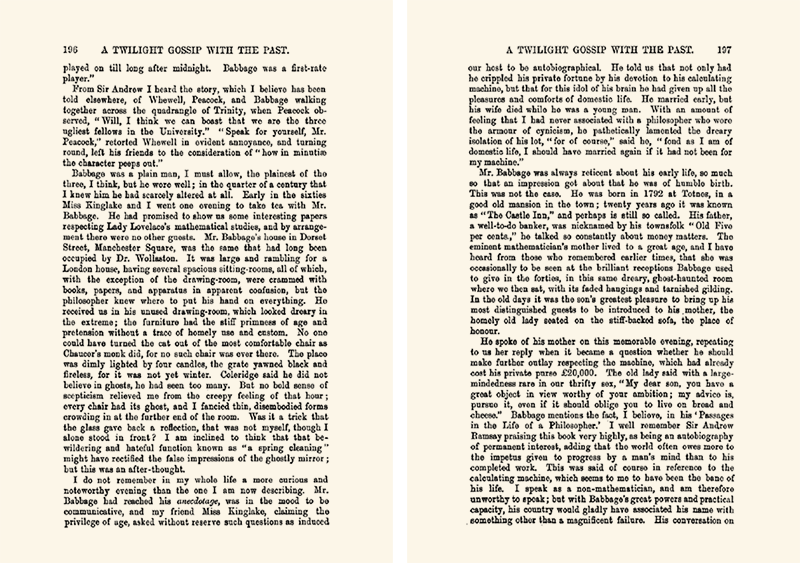
Apparently, he liked to say that he would gladly give up the remaining part of his life in three days, spent in the future after 500 years. When he died, his brain was saved, and he is still exposed ...
And let Babbage never built his differential machine; the Swedish company did it for him, even demonstrating a part of it at the world exhibition. When Babbage died, many of the documents and components of his project on a differential machine went to his son, Major General Henry Babbage, who published some of these documents, and privately assembled several devices and some components of the analytical computer. Meanwhile, a fragment of the differential machine, built in the days of Babbage, was exhibited at the Museum of Science in London.
Reopen
After Babbage's death, his life's work — the works on creating computers 1 were all forgotten (although, for example, they were mentioned in Encyclopaedia Britannica from 1911 ). Nevertheless, mechanical computers continued to develop, gradually yielding to electromechanical, which, in turn, gave way to electronic. And when in the 1940s people began to delve into programming, Babbage's work and Ada's notes were remembered again.
People knew that AAL is Ada Augusta Lovelace, and that she was Byron's daughter. Alan Turing read her notes and coined the term “ Lady Lovelace's objection ” ( about AI’s inability to create and build ) in his article on Turing ’s 1950 test . But Ada itself was represented in it only by a footnote.
There was a certain Bertram Bowden - a British nuclear physicist who took up work in the computer industry and eventually became Minister of Education and Science, and who "re-discovered" Ada. In his book, Faster Thought from 1953 (yes, about computers), he writes that he contacted Ada's granddaughter, Lady Wentworth (daughter of Ada), who told him about family knowledge about Ada, both accurate and not so, and allowed him to study her work. Interestingly, Bowden notes that the book of Ada 's granddaughter, “On Thoroughbred Race Rocks and Their Pedigrees, ” uses a binary system in pedigree calculations. Hell, like the analytical machine, of course, used the decimal system, without considering the binary one.
But even in the 1960s, Babbage and Hell were not particularly known. The prototype of the Babbage differential machine was given to the Science Museum in London, but, although I was in my childhood (60s) and had been there many times, I am sure that I had never seen it there. However, in the 1980s, especially after the US Department of Defense called its ill-fated programming language after Ada, the awareness of Ada Lovelace and Charles Babbage began to increase, and their biographies began to appear, sometimes full of idiotic mistakes (my favorite is where the mention of the three-body problem , in a letter from Babbage, is interpreted as a romantic triangle between Babbage, Ada and William, although it was a question of the three-body problem from celestial mechanics!).
As interest in Babbage and Ada grew, curiosity grew as to whether a differential machine would work if built according to Babbage's drawings. The project was started, and in 1991, after the titanic efforts, a complete version of the differential machine was built (and the printer was added in the 2000th) with only one correction in the drawings. Surprisingly, the car worked. Construction cost about as much (adjusted for inflation) as Babbage requested from the British government back in 1823.
As for the analytical machine, no version of it has ever been created, even the model that simulates it.
What actually wrote ada
So now, after I told (in great detail) about the life of Ada Lovelace, what exactly was in her notes about the analytic machine?
It starts without introducing: "a function whose integral the differential machine should consider is ... " Then she explains that the differential machine can calculate the values of any polynomials of the sixth degree, and the analytical machine is different in that it can perform operations in any sequence. Or, to quote: "The analytic machine is a reflection of the science of operations , constructed so that the abstract numbers are subjects of these operations. The difference machine embodies only one concrete, and a very limited set of operations ... "
Very charming, at least for me, considering how many years I have spent on Mathematica ; She writes a bit later: “ We can view the machine as a material and mechanical embodiment of the analysis , and that our actual capabilities in this section of human knowledge will be used more efficiently than before. This is necessary in order to keep up with our theoretical knowledge of these principles and laws. And this is realized through gaining complete control over the handling of algebraic and numerical symbols, which the machine gives us. "
A little later, she explains how punch cards are used to control the analytical machine, and then leads the classic phrase: "the analytical machine weaves algebraic patterns like a Jacquard loom, weaving flowers and leaves ."
Then, Ada examines how a sequence of individual types of calculations will be performed on the analytical machine with “ operational maps ” that define the sequence of operations, and “ variable maps ” with which values are set. Ada talks about cycles, and cycles of cycles, etc., currently known as cycles and nested cycles, defining a mathematical notation for them:
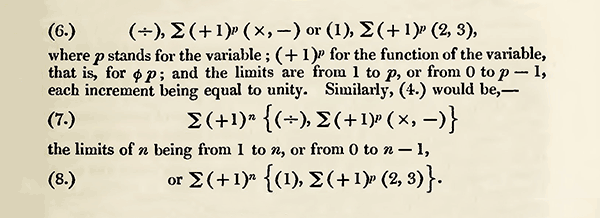
The records of Ada contain a lot of things that seem very modern. She writes that " there is a certain beautiful woven portrait of Jacquard, for the production of which it took 24,000 cards ." She then discusses the idea of using cycles to reduce the number of cards, and the meaning of reordering operations in order to optimize their performance on the analytic machine, eventually showing that with just three cards, you could do something that without cycles would require 330.
Ada talks about how far the analytical machine can go in its capabilities, making it computable (at least with some accuracy) that previously seemed impossible. , , " 295 " .
, Note G ( G, — ) : " - . , … , , ".
, , : , . , " " , , " , ". , — - , - ; .
, " , , , , , ". , (. " ") — , , .
, , , " ", , . , , " , ". 1843- .
Note G. , 1843 . : " , ; (, , ) ". , : " , , … ".
...
. , 17- , ,
 m n . , m , , . 1713 , 10 « », .
m n . , m , , . 1713 , 10 « », ., , , , Wolfram Language :

, , , , 10 .
, ? , :

, , B n , :

, . -, , B 1 ) , B n , B 2 n ( BernoulliB[2n] Wolfram Language). B 0 , B n n , . ( ):

, ( « ») " " (Mill), , " " ( , " "). ( , .) . . , B 8 ( B 7 ):
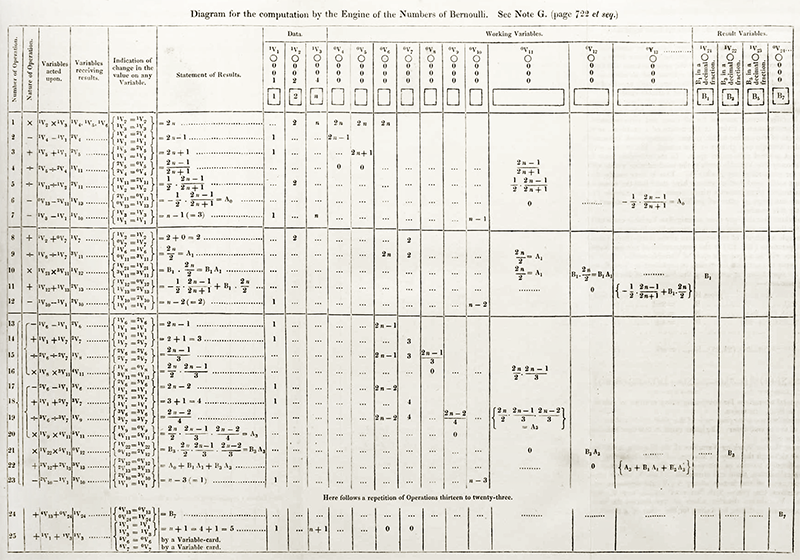
, , 25 ( ). , , . , , .
, 24:

, 4 , - . , , :
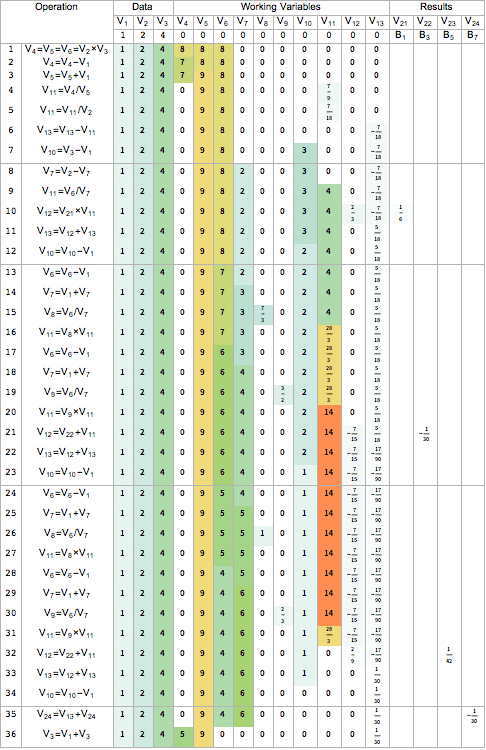
, () . , ( ), .
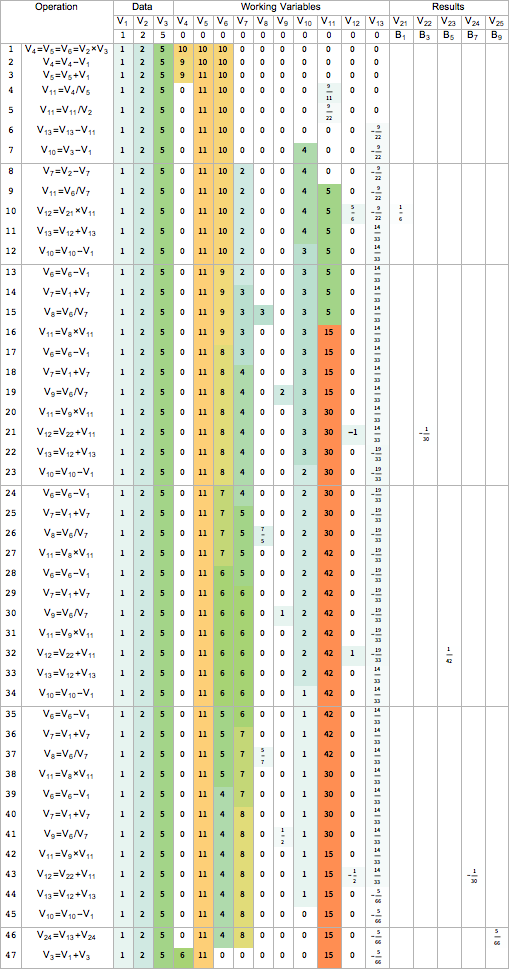
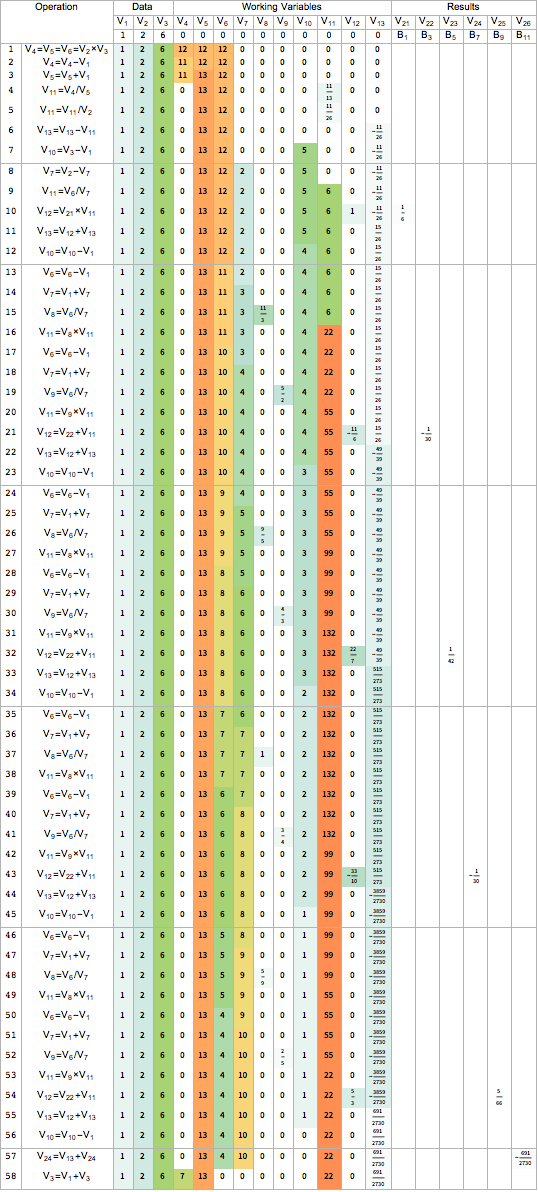
, 1843-, 40- , , , B 50 (=495057205241079648212477525/66). ; 7 . , B 8 5 , B 50 — - .
, , , , , , .
vs. ?
. ? . . , ; : " , , ".
( ) — 1830- , “ ” “ ”. — . , , , , .
, " ", . " 446- ", , — , — . 1830-, 1840-, 1843-.

, , , . , 1837-: " ", :
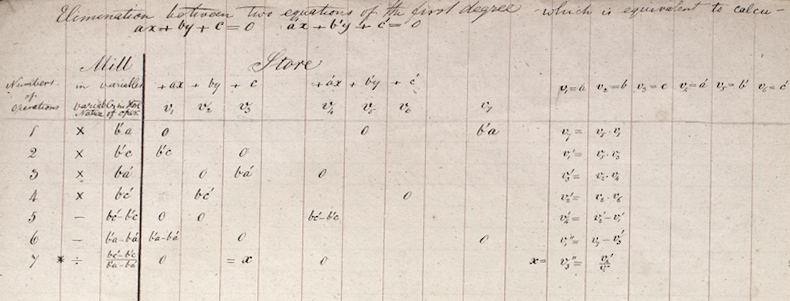
:
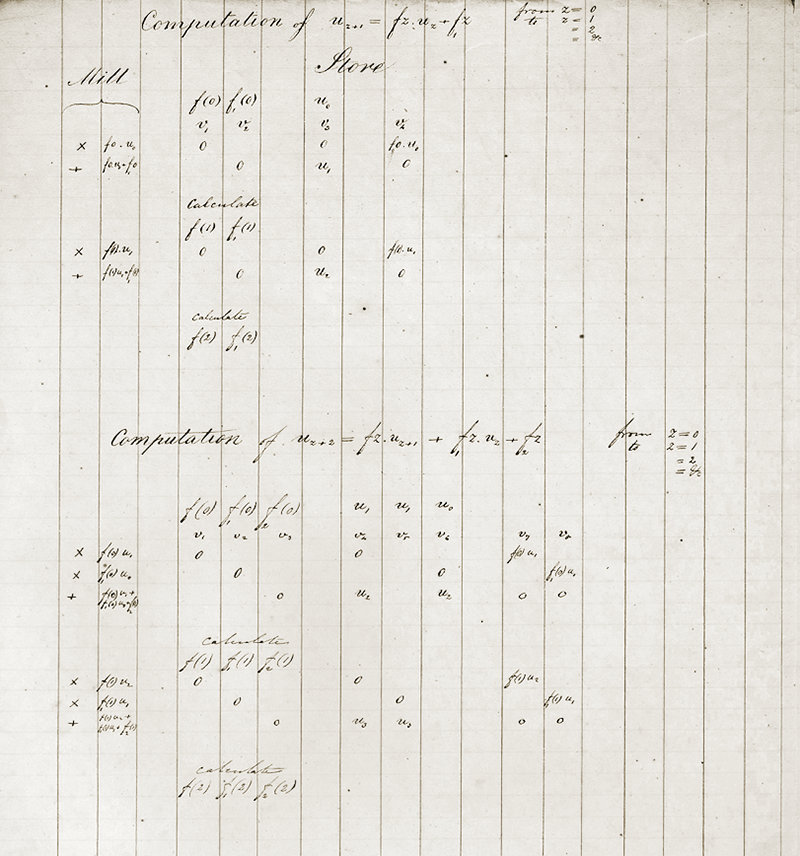
, 1838-, :
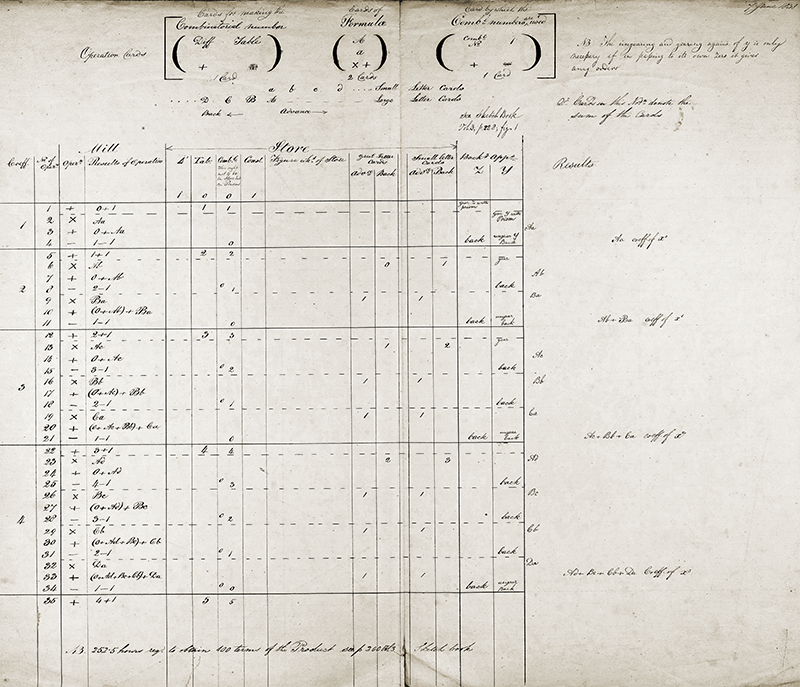
. , , , .
, ? , 26 , - - - . : " , ; , . , , , , , , . , , . "
, , , . , , , , , .
, , : , , , . , . — , . ( .)
With all its flaws, the fact that Babbage figured out how to build a (and, moreover, functioning) difference machine, not to mention an analytical machine, is quite impressive. So how did he do it? I think the key was in its mechanical notation. He first wrote about it in 1826 in an article titled " Methods for Designating Machine Operations by Symbols ". His idea was to take a detailed structure of the machine and present it using symbolic diagrams of how the components should interact. As a first example, he cites a hydraulic device:
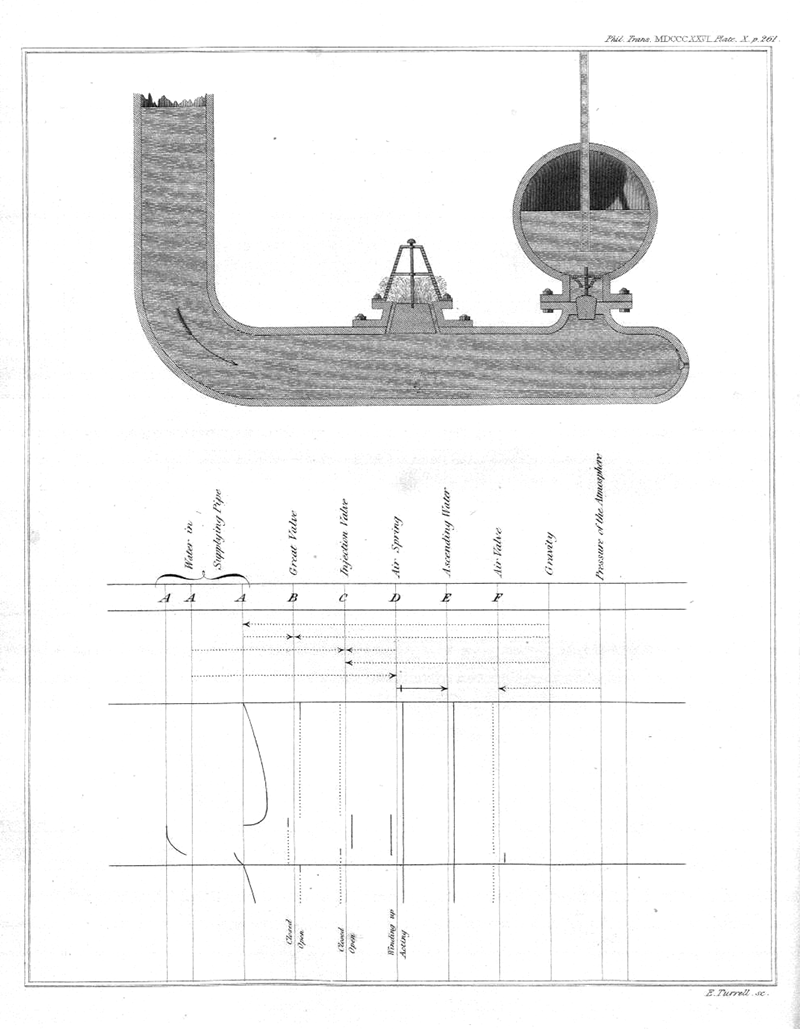
He then gives an example of a clock, showing how the parameters of the clock components change in a kind of “execution trace” on the left, and something like a block diagram of their interrelationships on the right:

This is a pretty good way of presenting how the system works, which in some respects is similar to modern time diagrams, but something is still different. And over the years that Babbage spent at work on the analytical machine, his notes began to contain more and more complex schemes. It is not entirely clear what the following means:

However, you can see an amazing similarity with modern representations in the Modelica language, like, say, in Wolfram SystemModeler. (One of the differences with modern concepts is that in our time subsystems are represented much more hierarchically, as well as the fact that all representations are now computable, and from them you can simulate the actual behavior of the system.)
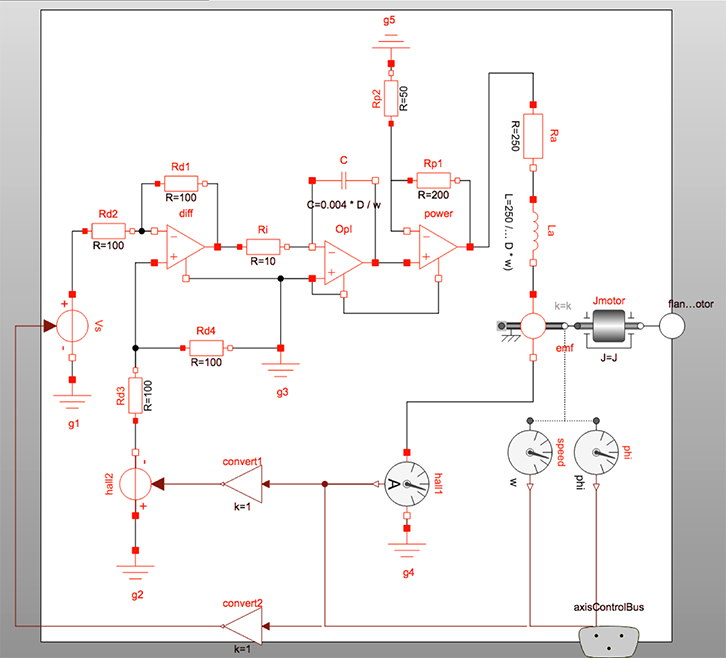
Babbage actively used his various charts in the records, but he never published anything about them. In fact, there is only one more of his printed work on mechanical notation - a booklet distributed at the World Exhibition in 1851 - apparently as a step towards standardization of drawings of mechanical components (and these designations, like the above, periodically appear on Babbage diagrams ).
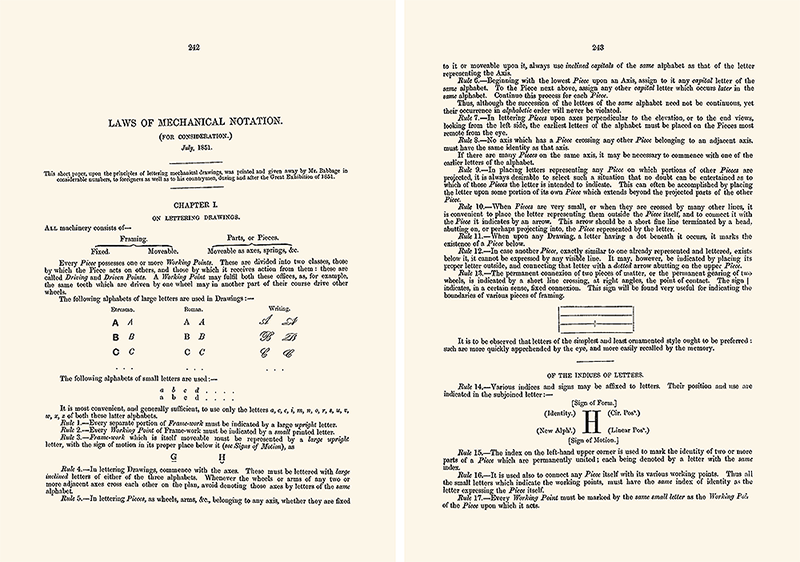
I'm not sure why Babbage didn't write anything else about his mechanical notation and diagrams. Perhaps he was in bitterness because in 1826 people could not realize the value of these ideas. Or perhaps he saw them as a “ secret ingredient, ” allowing him to create his own projects. And let the engineering systems have come a long way since the days of Babbage, but his ideas can still be a source of inspiration.
On a larger scale
So, how does everything happen with Ada, Babbage and the analytic machine on a larger scale?
Charles Babbage was an energetic man, had many ideas, and some of them were quite good. At 30, I wanted to create mathematical tables using a machine, and never abandoned my idea for the next 49 years, while inventing an analytical machine to achieve this goal. He was excellent, perhaps even gifted with regard to the engineering part. But he was very bad at choosing a trajectory for the project, its leadership.
Ada Lovelace was a smart woman who made friends with Babbage (there is no evidence that they ever had something romantic). Thanks to Babbage, she described the principles of the analytical machine, and at the same time brought in a more abstract vision than Babbage, as well as an idea of the incredibly powerful idea of universal computing.
A difference machine and similar devices are special purpose computers, the hardware of which is designed only to do something one specific. It would seem that in order to do a lot of different things, you will need a large variety of computers. But it is not. Instead, we are faced with the fundamental fact that general-purpose computers can be made, where a single and fixed piece of equipment can be programmed to do any kind of computation. And it was this idea of universal computing that made it possible for software to exist, which launched the 20th century computer revolution.
Back in the 17th century, Leibniz already had a philosophical concept about something like universal computation. However, this topic has not received development. And the Babbage analytical machine is the first and explicit example of machines known to us that can perform universal calculations.
Babbage did not reflect on this in a similar perspective. He just wanted to create a machine that would be as efficient as possible in the production of mathematical tables. But in an effort to develop it, he came to the concept of a universal computer.
When Ada wrote about Babbage's car, she wanted to present it in the clearest light, and therefore considered the car more abstractly, as a result of which she discovered and presented what you can now learn the concept of universal computing.
The works of Ada remained in obscurity for many years. However, on the margins of mathematical logic, this idea of universal calculations has resurfaced, most clearly expressed in the work of Alan Turing from 1936. Then, after the creation of electronic computers in the 1940s, it became clear that they had the capacity to produce universal computing, which connected them with the work of Turing.
True, there were suspicions that perhaps some other ways of implementing computers would require other forms of computation. And they existed until the 1980s - the moment when the concept of universal computing became a generally accepted and stable concept. And by that time, something new had appeared, including my work — that universal computing was not just something possible, but something quite common.
And now we know (which is embodied, for example, in the principle of computational equivalence ) that a very wide range of systems, moreover, even very simple structures, is capable of producing universal calculations.
The differential machine did not reach this threshold. But if it is improved a little, she will get that opportunity. Thus, in retrospect, it does not seem surprising that the analytical machine could carry them out.
Today, surrounded by computers and programs, the concept of universal computing seems almost obvious: of course, we can use programs to calculate what we want. But in theory it is not at all obvious. I think it can be said that Ada Lovelace was the first person who saw with all clarity that determined the development path of our technologies and even civilization - the concept of universal computing.
What if…
What would happen if it were not for Ada's health problems, and if she could successfully complete a project to create an analytical machine? What would happen after that?
I have no doubt that an analytical machine would have been built. Perhaps Babbage would have to revise his drawings a little, but I am sure that he would force it to work. Gizmo would have been the size of a railway locomotive, with about 50,000 moving parts. And there is no doubt that the machine would be able to calculate the mathematical tables with an accuracy of 30 or 50 characters, approximately one result in every 4 seconds.
Would they have thought that the machine could be electromechanical, and not purely mechanical? I think yes. After all, Charles Wheatstone , who was closely associated with the development of the electric telegraph in the 1830s, was their good friend. And, transmitting information through electrical wires, rather than mechanically through rods, the complexity of the design would be significantly reduced, and its reliability (which would be a big problem) would increase dramatically.
Another important factor in reducing the hardware of computers is the use of the binary system instead of decimal. Would they come to this idea? Leibniz knew about the binary system. And if George Boole began to work with Babbage after their meeting at a big exhibition, perhaps they would have come to something. The binary system was not widely known in the middle of the 19th century, but it was often encountered in puzzles and puzzles Babbage was fascinated with; a vivid example was his question about how to make a square of words with the word “bishop” on top and on the sides (the answer to which would require only a few lines of code on the Wolfram Language ).
Babbage's main concept regarding the analytical machine was the automatic creation of mathematical tables and their subsequent printing, or output them in the form of graphs. He imagined that these tables would be used by people, plus he developed the idea of some libraries with precomputed maps that would be machine readable versions.
In our time, say, in the Wolfram Language, there is no need to store mathematical tables; you can simply calculate what you need and when you need it. But in the days of Babbage, with his idea of a huge analytical machine, this was simply unthinkable.
OK, but would an analytic machine be used for something other than calculating math tables? I think yes. If Ada had lived as much as Babbage, she would have caught the 1890s — the time when Herman Hollerith developed an electromechanical card-based device for the census (which, by the way, was one of the founders of what turned IBM into ). An analytic machine could give much more.
Perhaps Ada would have realized her idea of using an analytical machine to automatically create algorithmic music . Perhaps the machine would be used to solve the three-body problem; perhaps even through modeling. If they had thought of using the binary system, perhaps they would have implemented systems like cellular automata.
Neither Babbage nor Ada never earned money in commerce (and, as Babbage strongly emphasized, his government contracts served only to pay for his engineers, but he himself did not receive anything). If they had developed an analytical engine, could they find a business model for its implementation? Surely they would sell several versions to various government agencies. Perhaps, they would have created some kind of remote computing service that serves the service of Victorian science, technology, finance, and others.
But all this didn’t really happen, and instead, Ada died young, the analytical machine was never finished, and the potential for computing was rediscovered only in the 20th century.
What were they like?
If you met Babbage, how would he appear? He was, I think, a good conversationalist. At the beginning of his life, he was an idealist (“ to do everything possible to leave the world wiser than the one I came to ”); he later turned into an almost Dickens caricature of a fierce old man. He made wonderful receptions and attached great importance to connections with the intellectual elite. But, especially in recent years, he spent most of his time alone in his big house filled with books, articles, and unfinished projects.
Babbage did not particularly understand people, and even at his eighty he was like a child in his polemics. He also had problems focusing on a single problem - he was constantly distracted by his new ideas. There was only one big exception - his almost 50-year-old labor in an attempt to automate the process of computing.
I myself pursue similar goals (more precisely, their modern versions) in my life (..., Mathematica , Wolfram | Alpha , Wolfram Language , ...), but so far only for forty years. I am lucky that I live at a time when the available technologies make it much easier to achieve this, but every major project I was engaged in required remarkable dedication, perseverance and leadership qualities to bring it to the end.
So what about hell? First of all, it is a clearly articulating and clearly thinking person. She came from the upper class, but did not wear particularly fashionable clothes, and was far less stereotypical Countess than an intellectual. She was an adult and emotionally mature man; probably more mature than Babbage, and seems to have a good applied understanding of people and the world around them.
Like Babbage, she was rich and she didn’t have to work for her life. But she was ambitious and wanted to do something herself. I suppose, behind the mask of a lady from the high society of the Victorian era, there was a kind of botanist with mathematical jokes and other attributes. She was also very focused and persistent, having spent, for example, several months writing her notes.
In mathematics, she successfully reached the level of knowledge of those times; Perhaps equaling with Babbage. However, we do not know, in contrast to the situation with Babbage, what exactly she did in mathematics, so it is difficult to judge her level; Babbage was respected, though unremarkable.
When you read Ada's letters, a smart, sophisticated person with clear logical thinking appears. Her speeches are often covered with Victorian courtesies, but under them are clear and often strong ideas.
Ada was clearly aware of her position in society, and the fact that she was “Lord Byron’s daughter”. In a sense, her success story is based on her ambitions and desires to try something new. (I cannot stop comparing it as a leading engineer in the creation of an analytical machine and Lord Byron, who heads the Greek army). But I also suspect that his problems affected her. For many years, partly due to the influence of her mother, she eschewed such things as poetry. Her gaze was turned to abstract things, not only to mathematics and science, but also to more metaphysical areas.
And, it seems, she concluded that her best application would be to work in combining the scientific and the metaphysical — perhaps this is what she called “ poetic science .” Perhaps her self-replication was true. Indeed, in a certain sense, it was precisely this that she did: taking the engineering part developed by Babbage, she created an abstract, “metaphysical” concept, which later gave us the first idea of the idea of universal computing.
Conclusion
The story of Ada and Babbage has many interesting moments. This is the story of a meeting of technical mastery with a broad abstract vision. This is a story about friendship between old and young man. This is the story of people who had the courage to be original and creative.
It is also a tragedy. The tragedy for Babbage, who lost so many people in his life, and whose personality repelled others and prevented him from realizing his ambitions. The tragedy for Ada, who had just found a cause for her life, as her health deteriorated.
We will never know what Ada could do. Is Mary Somerville another famous interpreter of Victorian science? What kind of Steve Jobs, forming the vision of an analytical machine? Or Alan Turing, who understands the abstract idea of universal computing?
The fact that Ada touched what will become the defining idea of our time was a great success. Babbage did not understand what he was dealing with; Ada saw glimpses and successfully described them.
For some people, in particular, for me, the story of Ada and Babbage causes a special resonance. Like Babbage, I spent most of my life pursuing specific goals, although, unlike Babbage, I managed to realize some of them. And I suspect that, like Ada, I was given the opportunity to see glimpses of some significant ideas of the future.
But the problem is to sufficiently “ be Ada ” to understand what awaits us, or at least “ find that Ada ” that understands. At least now, I suppose, I have an understanding of what Ada was, born 200 years ago: a decent person on the path to universal computing, present and future achievements in the field of computational thinking.
It was very nice to meet you, Ada.
Thanks
A lot of organizations and people helped me in obtaining information and materials for this post. I would like to thank the British Library , the Museum of the History of Science at Oxford , the Museum of Science in London , the Bodleian Library at Oxford (with the permission of Count Lytton, great-great-grandson of Ada, one of 10 living descendants of it), the Public Library of New York , the Holy Church Mary Magdalene (in Hucknall, Nottinghamshire - the burial place of Ada), Betty Toole (the author of the collection of Ada’s letters ), as well as two old friends: Tim Robinson (the person who recreated Babbage’s machine) and Nathan Mirvold (who finances the reconstruction of the second version of the differential machine).
Source: https://habr.com/ru/post/303552/
All Articles
